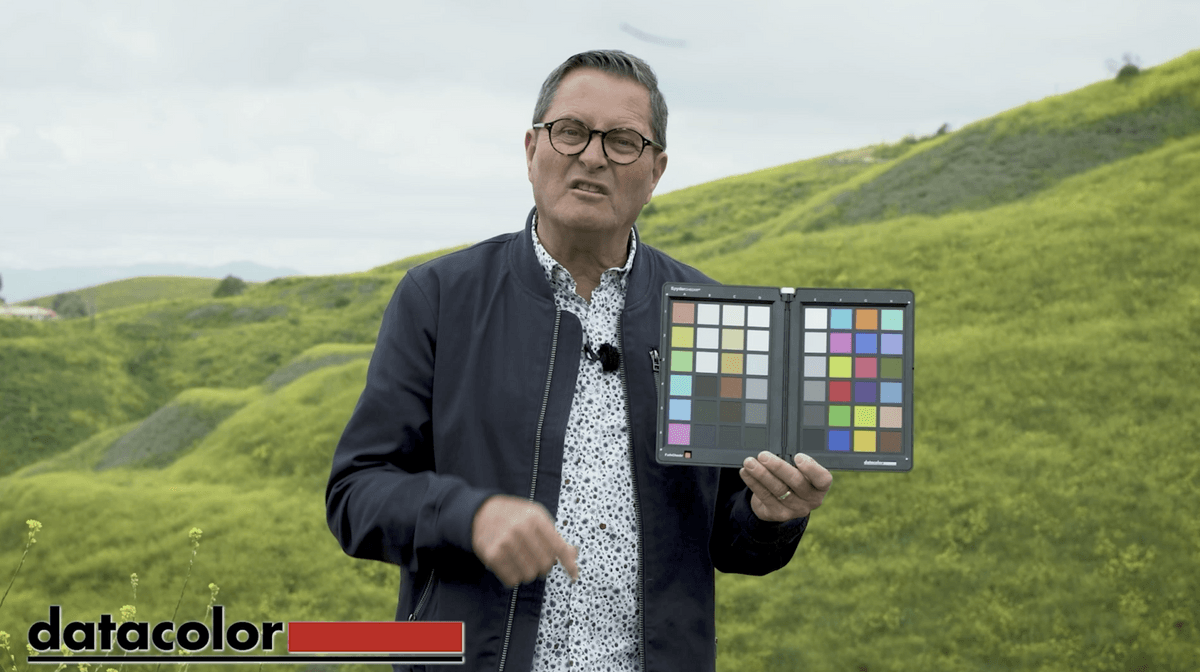A Canon camera comparison of the EOS R, R5 and R6. See how they compare head to head and see why we think the R is superior! We compare image quality, ISO settings, autofocus and more.
I think the Canon EOS R is the best mirrorless camera that Canon has ever made. And I’m going to prove it.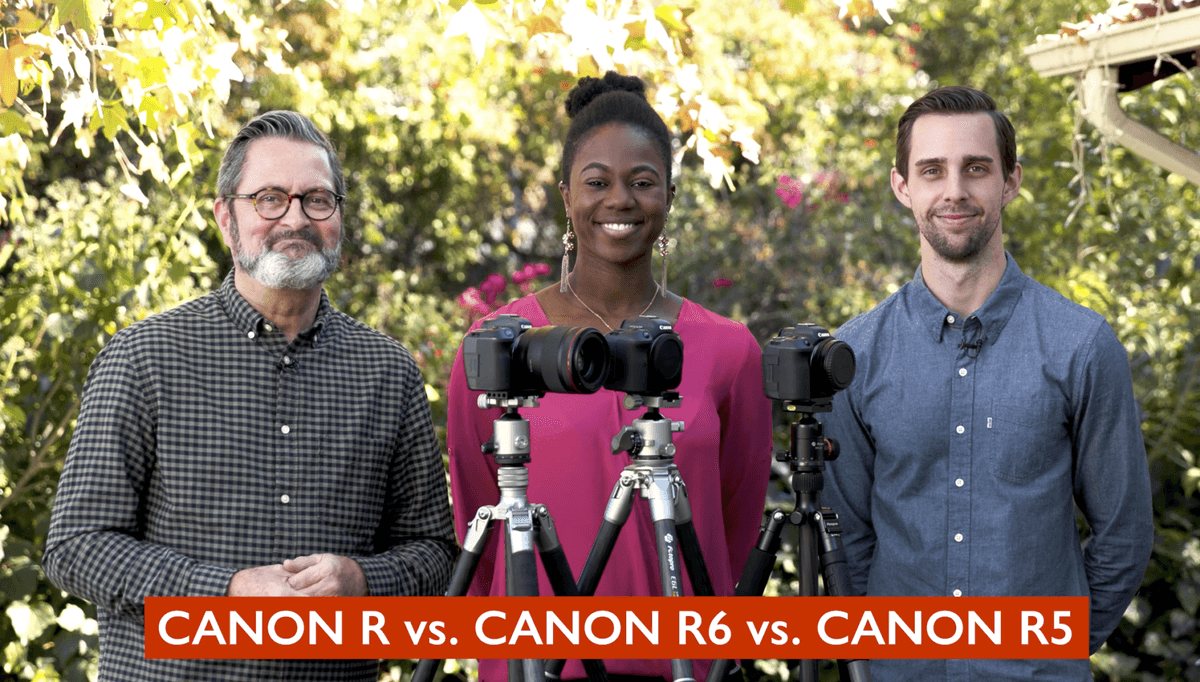
This Jay P. Morgan, today on The Slanted Lens we’re going to take a look at the question “What is the best Canon mirrorless on the market today?” You might think that’s very obvious, but I don’t think it’s quite as obvious as you might think.
I want to see how much of a difference there is when we compare the R to the R5 and the R6. We have both been really impressed with a lot of things about them. But the R still holds its own. So we want to compare the images side by side and talk about the focus.
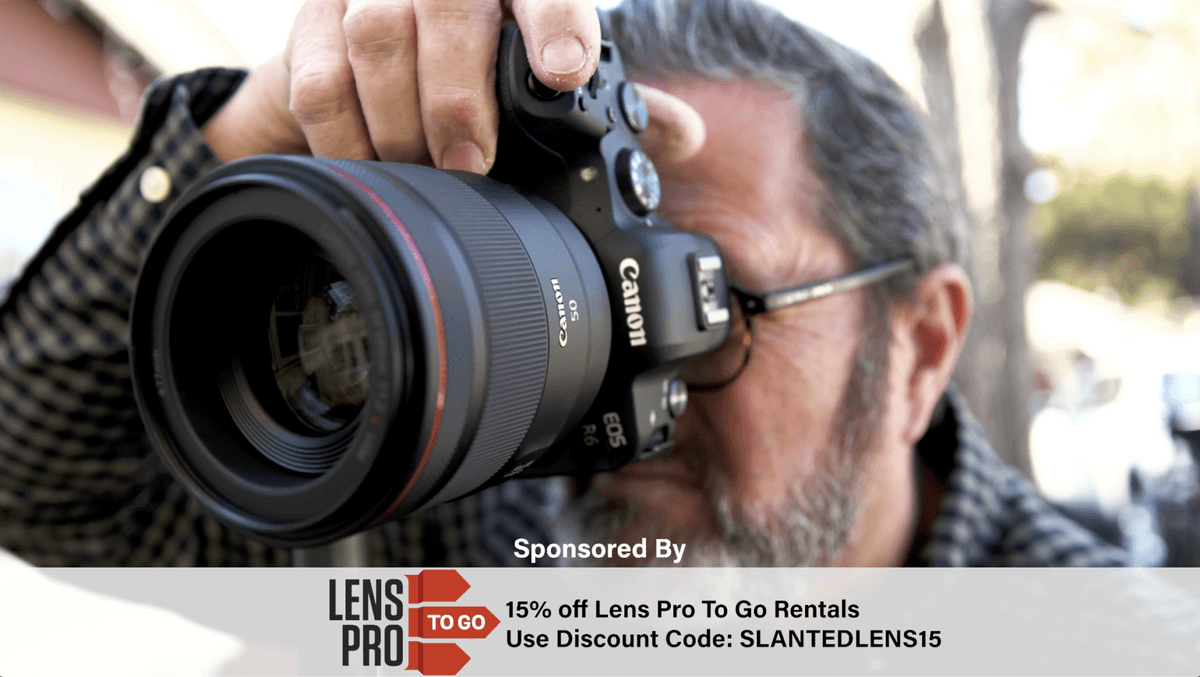 I want to give a special shout out to Lens Pro To Go which provided all of our cameras and lenses here today. That is an incredible company where you can get things to test and to be able to work with any kind of lenses and camera bodies that you need, it’s really a great place to be able to rent from. (Get 15% off Lens Pro To Go Rentals www.lensprotogo.com Use Discount Code: SLANTEDLENS15)
I want to give a special shout out to Lens Pro To Go which provided all of our cameras and lenses here today. That is an incredible company where you can get things to test and to be able to work with any kind of lenses and camera bodies that you need, it’s really a great place to be able to rent from. (Get 15% off Lens Pro To Go Rentals www.lensprotogo.com Use Discount Code: SLANTEDLENS15)
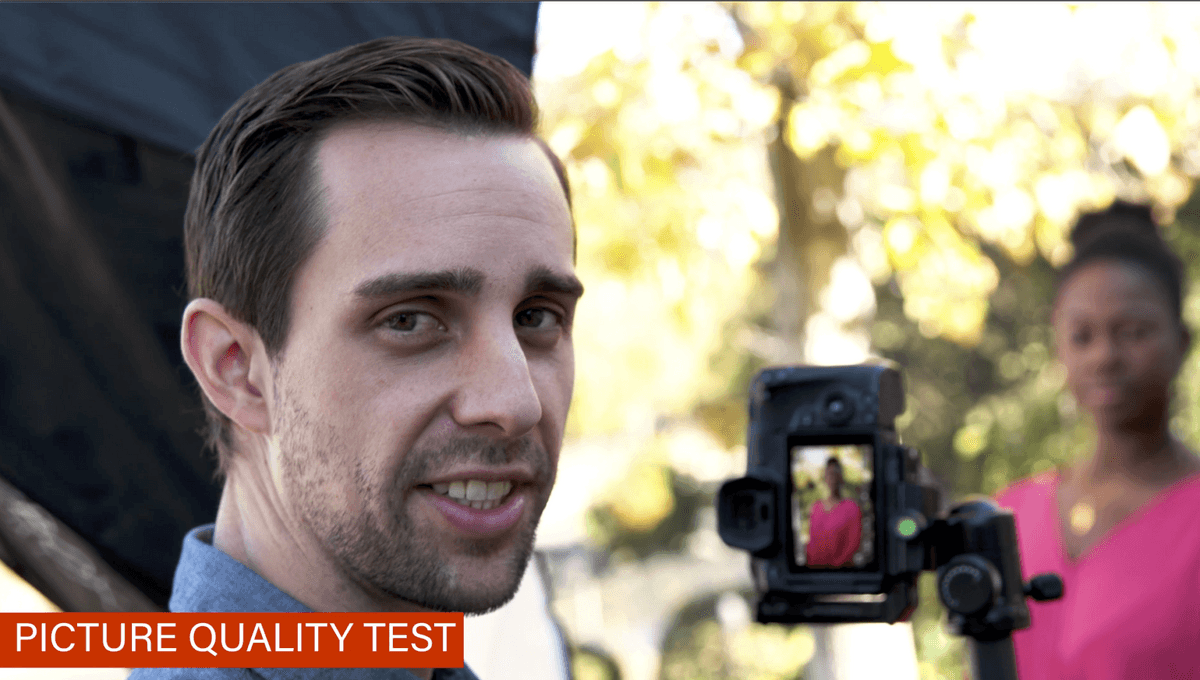 So we’re going to do the picture quality test. And this is where we’re going to see if there’s a difference. First of all, these cameras have very different ranges of resolutions, you have 20 megapixels with the R6, 30 megapixels with the R and then 45 megapixels with the R5, which is awesome.
So we’re going to do the picture quality test. And this is where we’re going to see if there’s a difference. First of all, these cameras have very different ranges of resolutions, you have 20 megapixels with the R6, 30 megapixels with the R and then 45 megapixels with the R5, which is awesome. 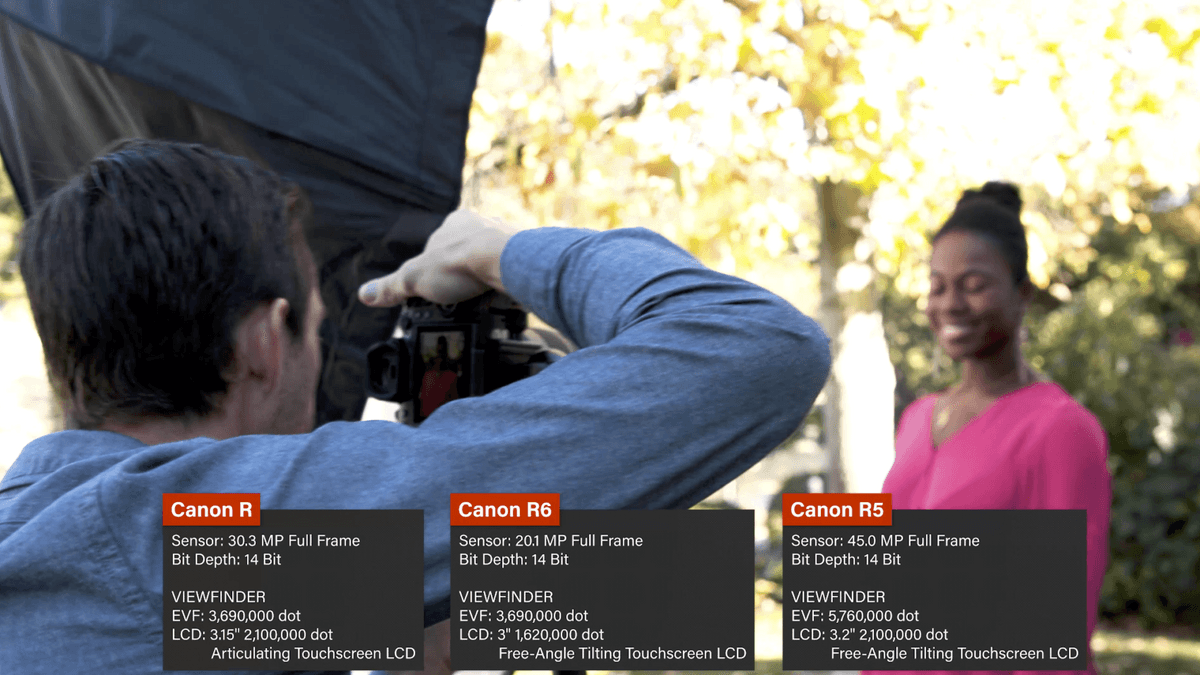 And then we’re also going to look at color tonality. How do they reproduce color? Is there a big difference between all these cameras? Are they all pretty similar because they’re all great candidates? I don’t know. We’ll check it out. I think we’re going to be surprised by the results.
And then we’re also going to look at color tonality. How do they reproduce color? Is there a big difference between all these cameras? Are they all pretty similar because they’re all great candidates? I don’t know. We’ll check it out. I think we’re going to be surprised by the results. 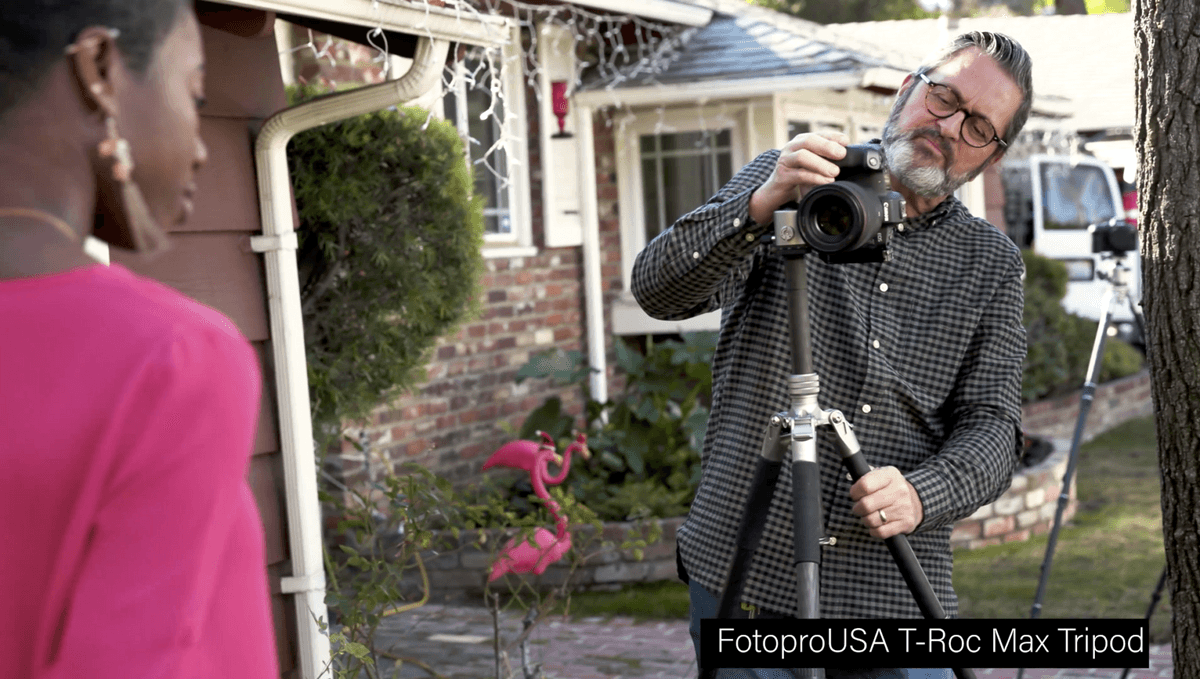 This is where I feel like these cameras are all super similar. I did do some adjustments to the light and the color just a little bit on each camera to get them closer together just to show how similar they can be. I honestly thought that that’s where we’d see the biggest difference is when you blow these up. And there’s so much more detail on the R5. And you can really get in there on her eyeball and see all the different eyelashes and stuff.
This is where I feel like these cameras are all super similar. I did do some adjustments to the light and the color just a little bit on each camera to get them closer together just to show how similar they can be. I honestly thought that that’s where we’d see the biggest difference is when you blow these up. And there’s so much more detail on the R5. And you can really get in there on her eyeball and see all the different eyelashes and stuff. 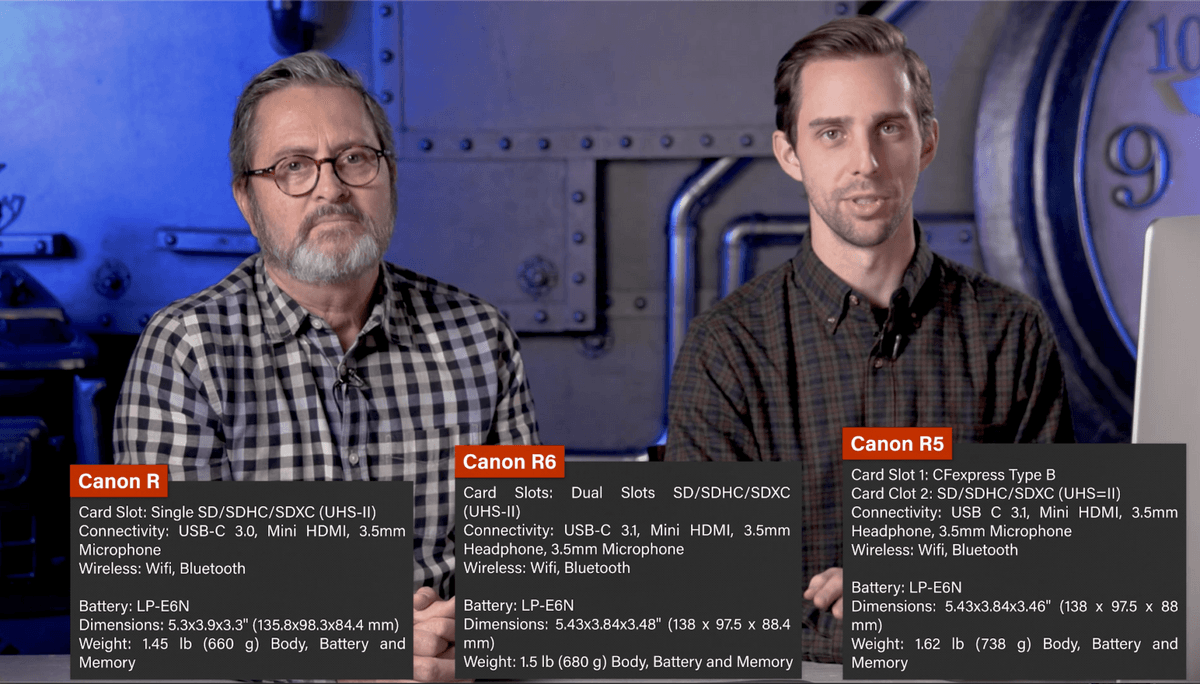 You don’t get quite the same amount of detail in the R, or the R6. But this is what’s interesting. The R and the R6 are actually very similar to me in terms of detail, even though one is 50% larger than the other. Yeah, the R6 is holding up much better than I thought it would. The image looks great. There’s a lot of detail there.
You don’t get quite the same amount of detail in the R, or the R6. But this is what’s interesting. The R and the R6 are actually very similar to me in terms of detail, even though one is 50% larger than the other. Yeah, the R6 is holding up much better than I thought it would. The image looks great. There’s a lot of detail there.
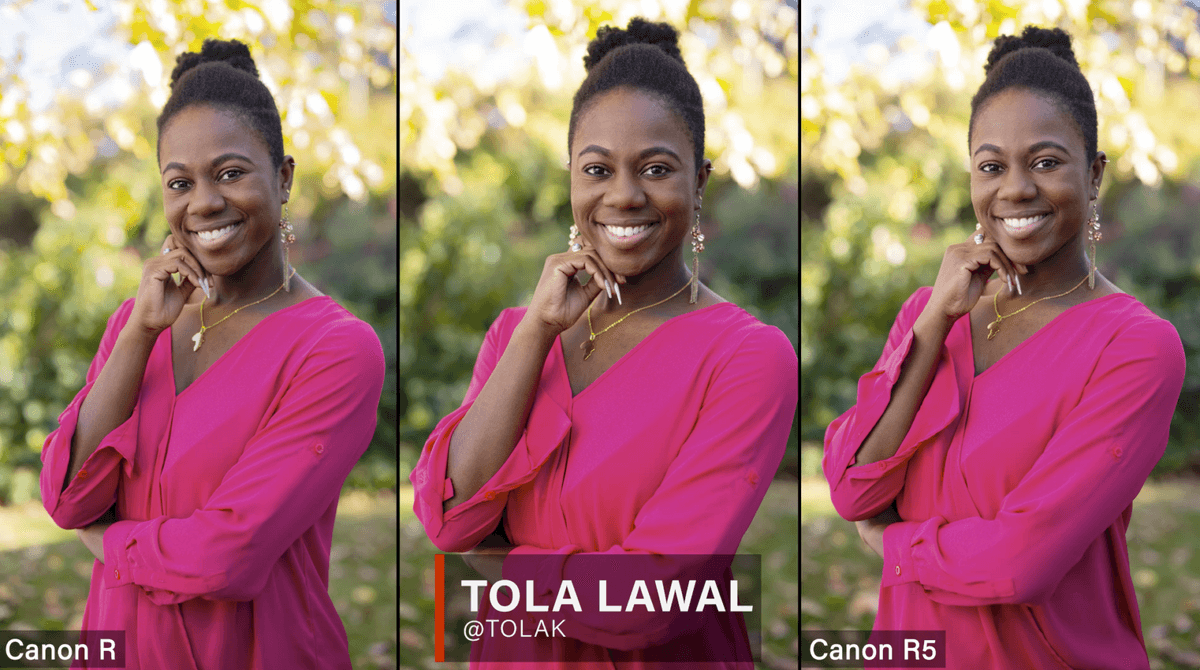
The color is a little better on the R5. I think it pops a little more and maybe a little more true overall with all these photos. The R6 color just felt a little less three dimensional. But we’re talking less than a 5% difference in my opinion.
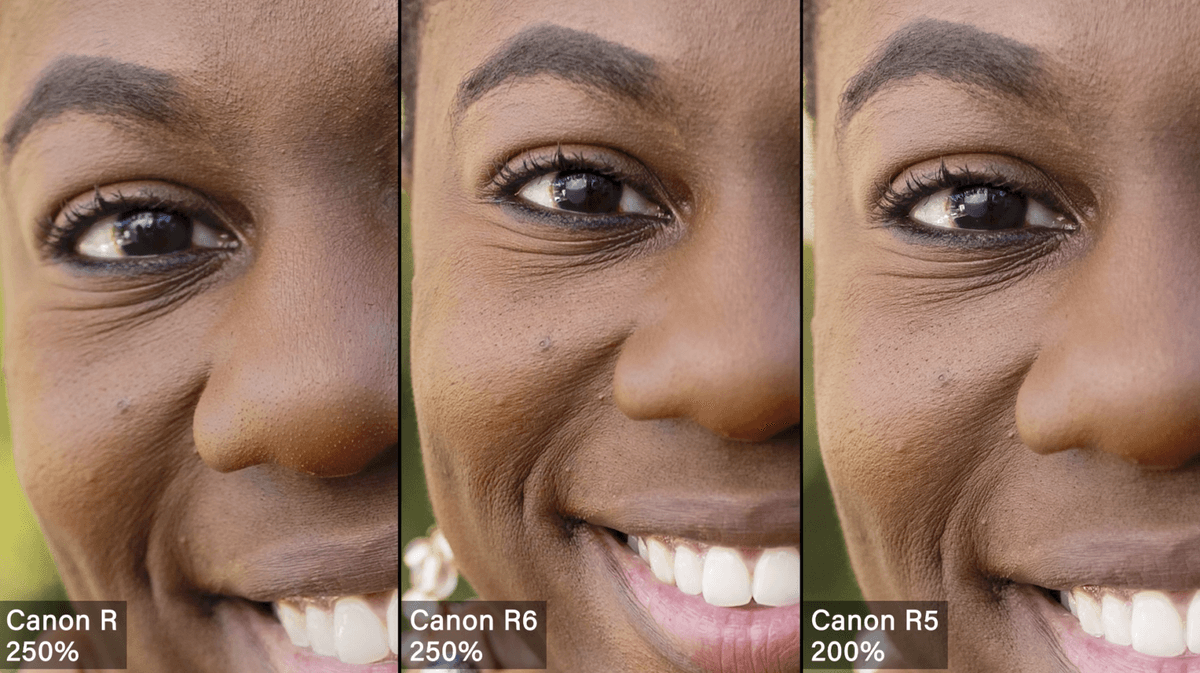
Overall, you just have to say you can correct these and they look very, very similar. And when you blow them up do you see that much detail difference in them? You see some. Actually the R5 is definitely better. It has a very technical amount of detail.
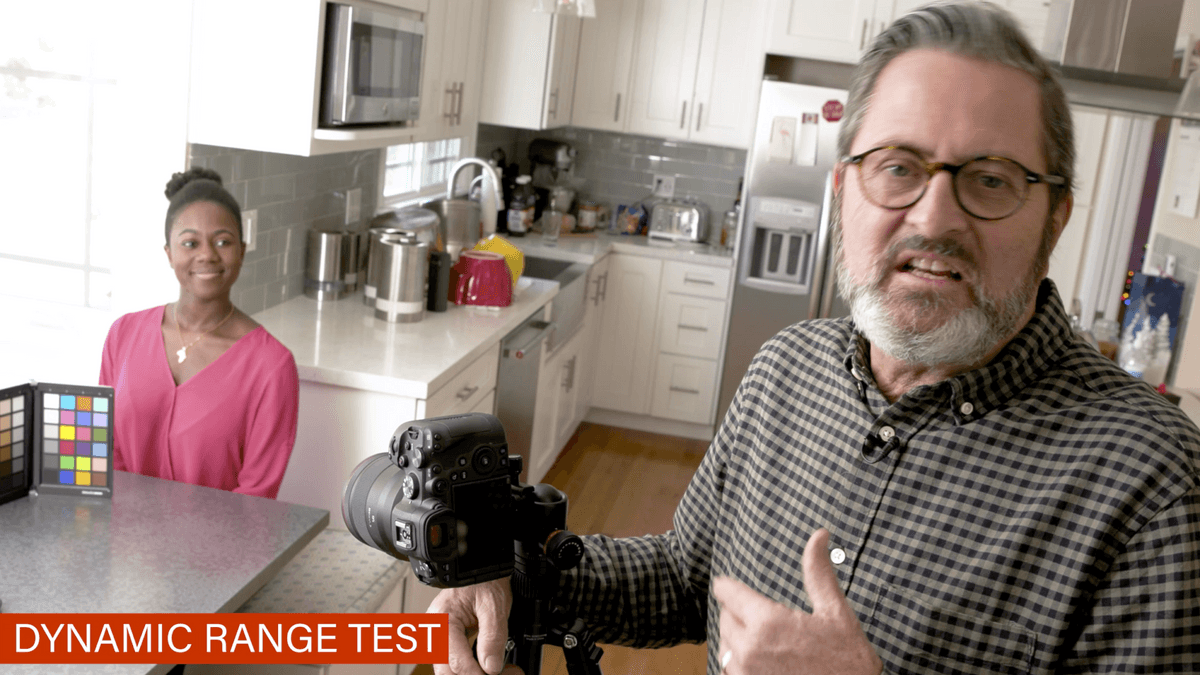
So it’s time to look at the dynamic range on each of these cameras. So the new R5 and R6 should have a better dynamic range and the R does. Most digital cameras fall apart when you overexpose them. You’re better to underexpose them. We’ll see what that dynamic range is and how it compares with each one of these cameras.
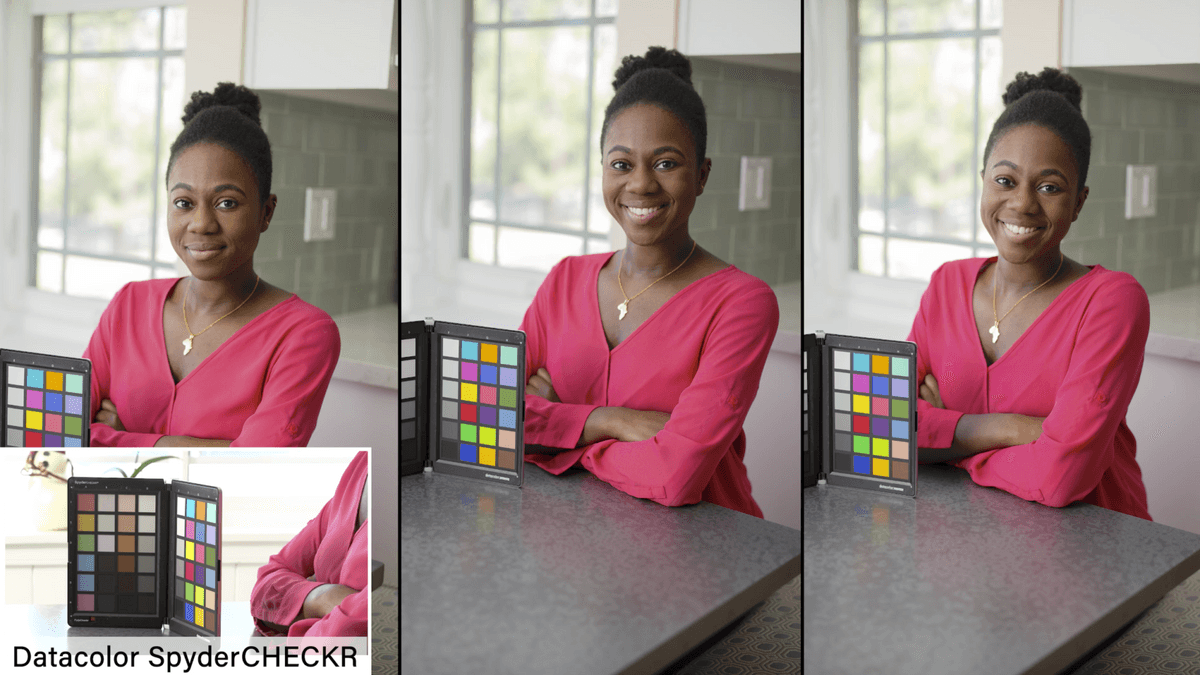
Here at zero I did try and match these at their starting exposure. They’re all looking good. They’re holding everything in the background. 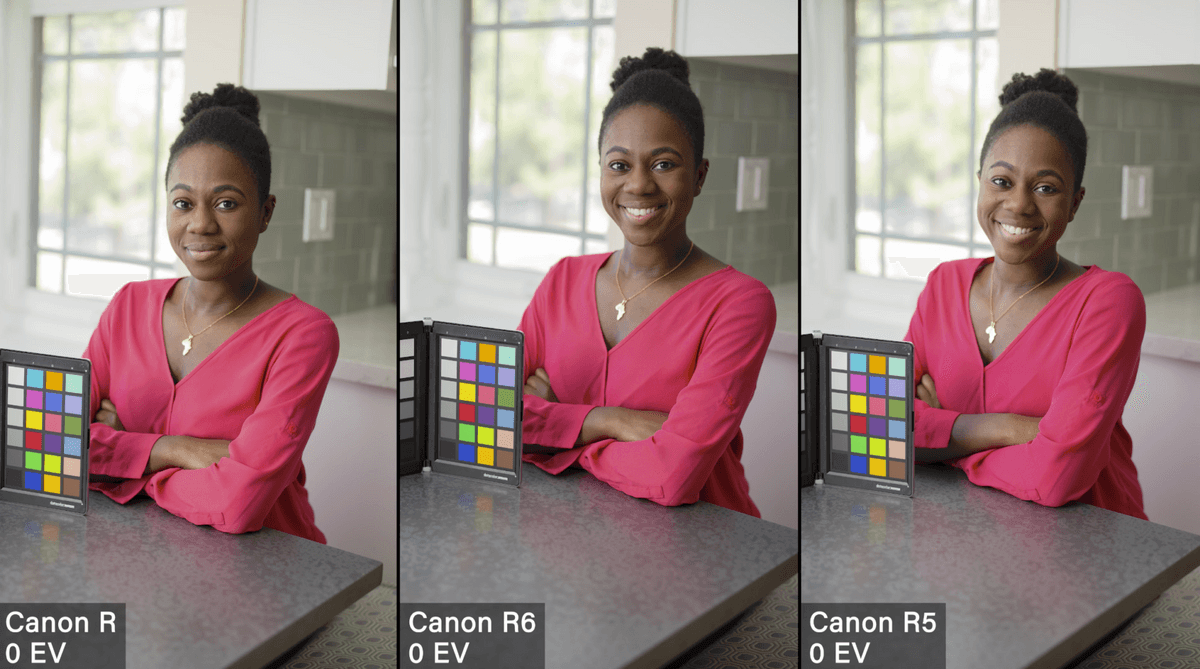 When we move to minus one exposure, under exposures are always just fine at minus one stop. We don’t expect to see anything until minus two or three stops.
When we move to minus one exposure, under exposures are always just fine at minus one stop. We don’t expect to see anything until minus two or three stops.
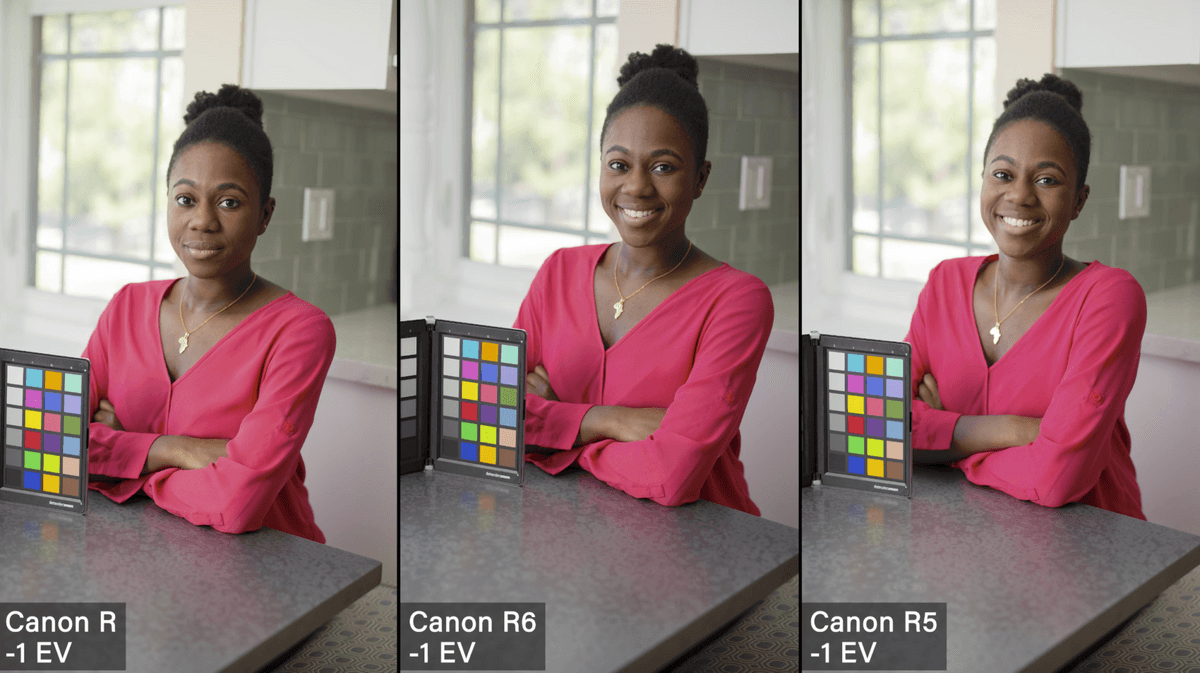 At two stops here, you’re really not seeing any difference in the images. We’re not seeing any grain build.
At two stops here, you’re really not seeing any difference in the images. We’re not seeing any grain build.
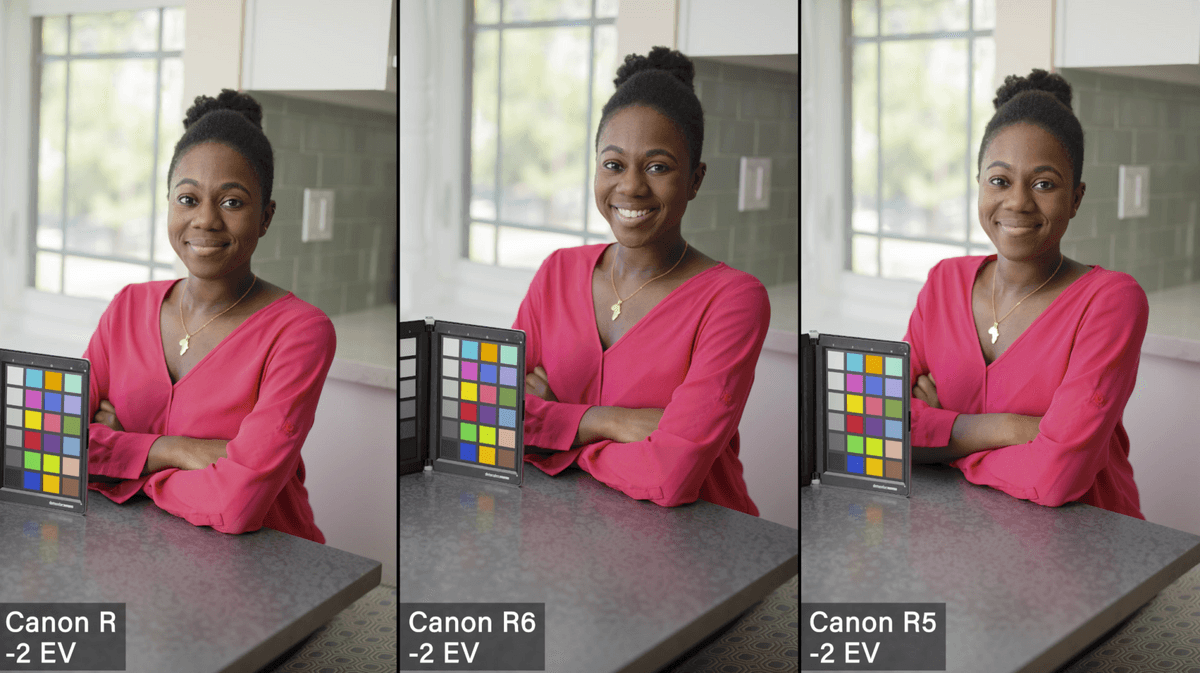
At minus three stops if you start zooming in you do start to see a little bit of of texture in the shadow, but her skin still looks really clear on all the cameras. 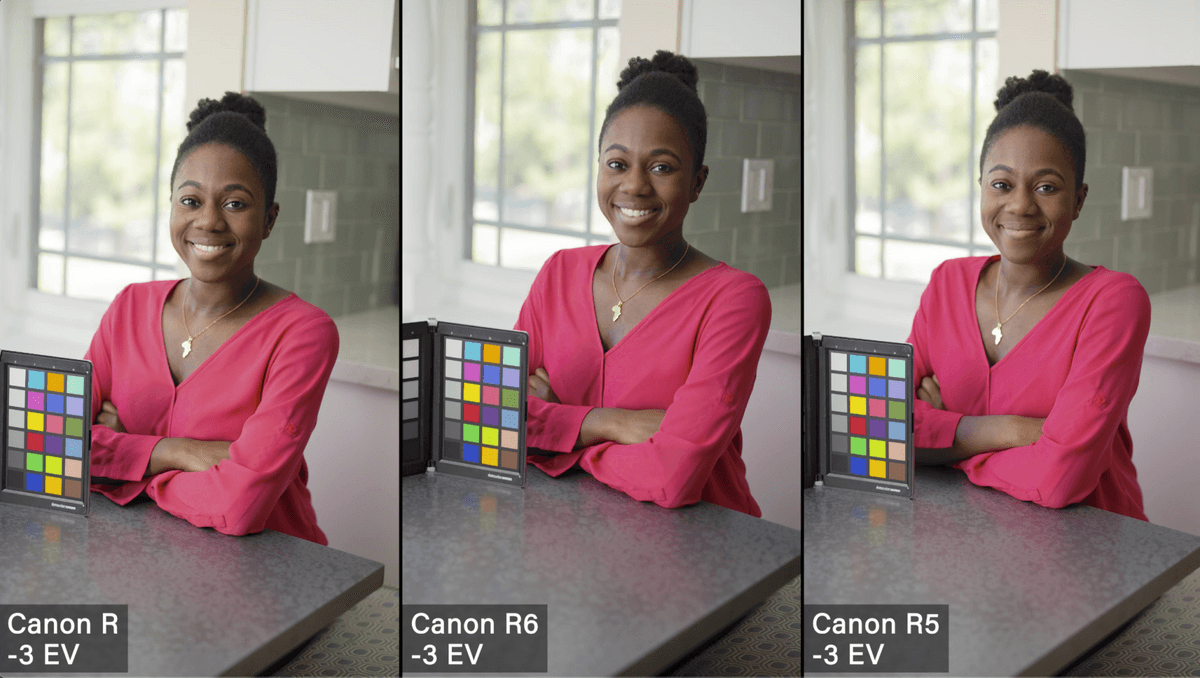 Actually the R6 looks the most neutral right now. You definitely are seeing a little bit of a cool green coming on with the R.
Actually the R6 looks the most neutral right now. You definitely are seeing a little bit of a cool green coming on with the R.
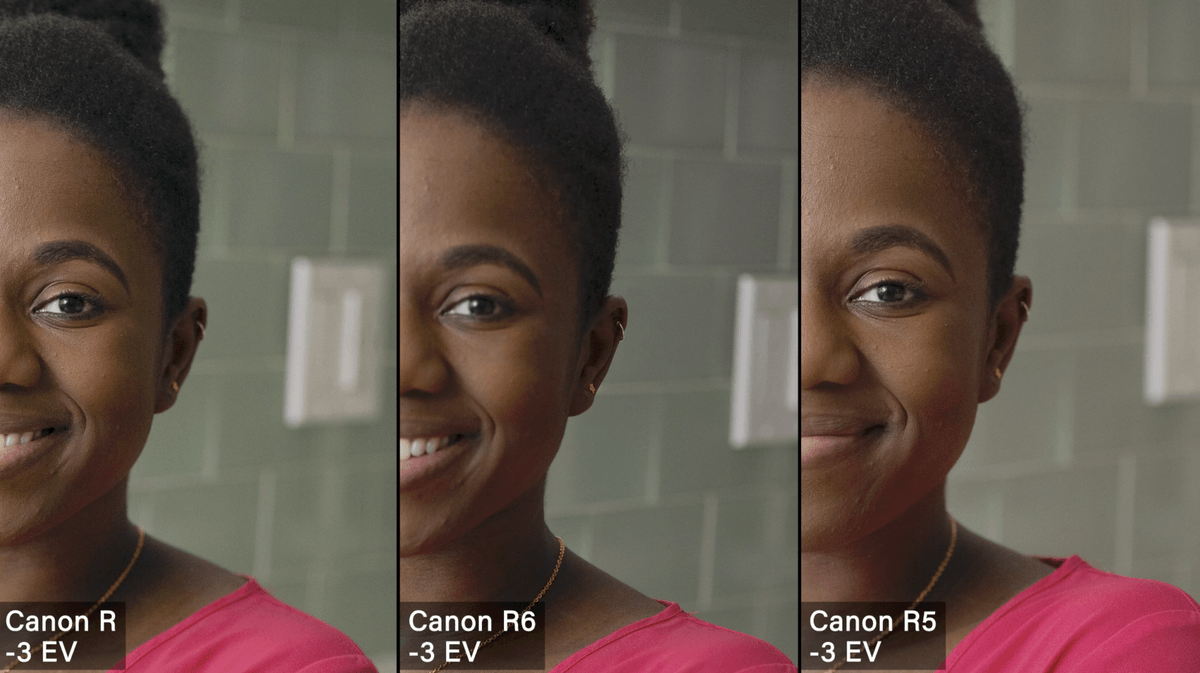
Here we move to minus four stops. I mean the R6 is looking beautiful, you do have some grain behind her head on the wall but overall it’s looking really pretty. 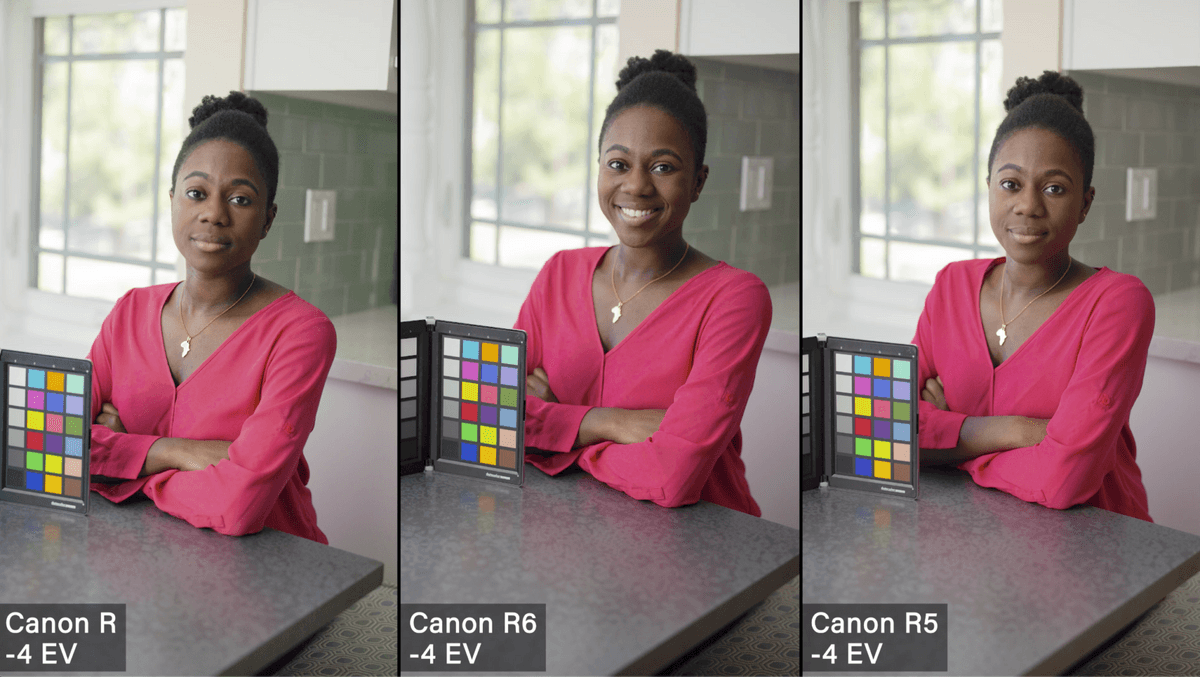 Same with the R5 really pretty. The R is starting to go a little weird with the color. At minus four stops the color is starting to shift a little bit.
Same with the R5 really pretty. The R is starting to go a little weird with the color. At minus four stops the color is starting to shift a little bit. 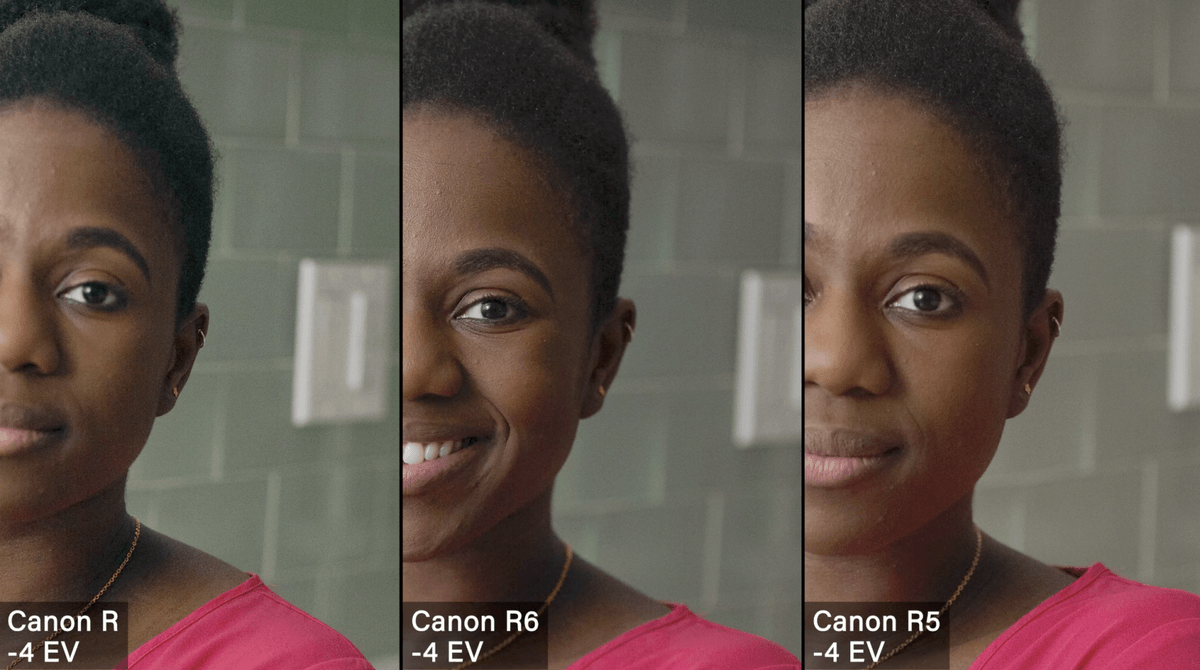 We’re seeing a little bit of grain building as well in the background. Even zooming back out with the R5 you can see the color is shifting a little bit. It’s kind of turning magenta. And the R is looking a little green. The R6 is looking great.
We’re seeing a little bit of grain building as well in the background. Even zooming back out with the R5 you can see the color is shifting a little bit. It’s kind of turning magenta. And the R is looking a little green. The R6 is looking great.
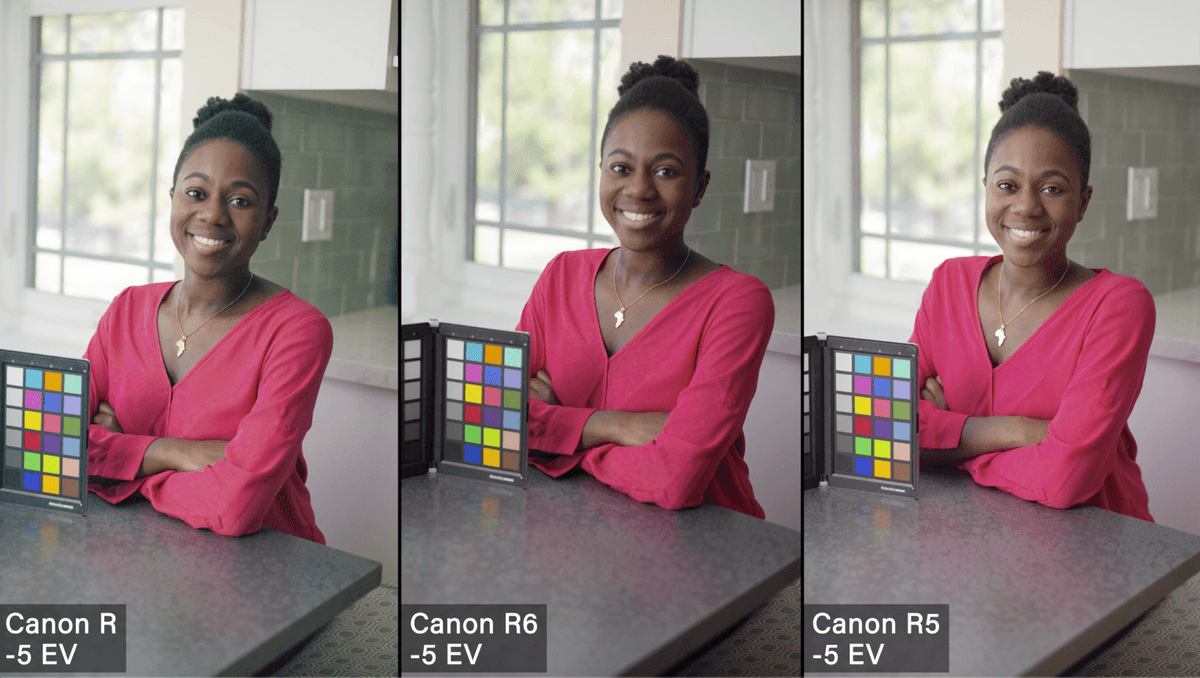
At minus five stops it was really dark and the color in the R6 and everything is just holding so well. There is some texture and banding in the shadows. Now you can see the green and magenta splotches. With the R5 the blacks have lost their strength and it’s kind of red in the skin tones. Now we’re going green with the R. The R is going really contrasty. It’s not holding on to the shadows and there is a lot of banding.
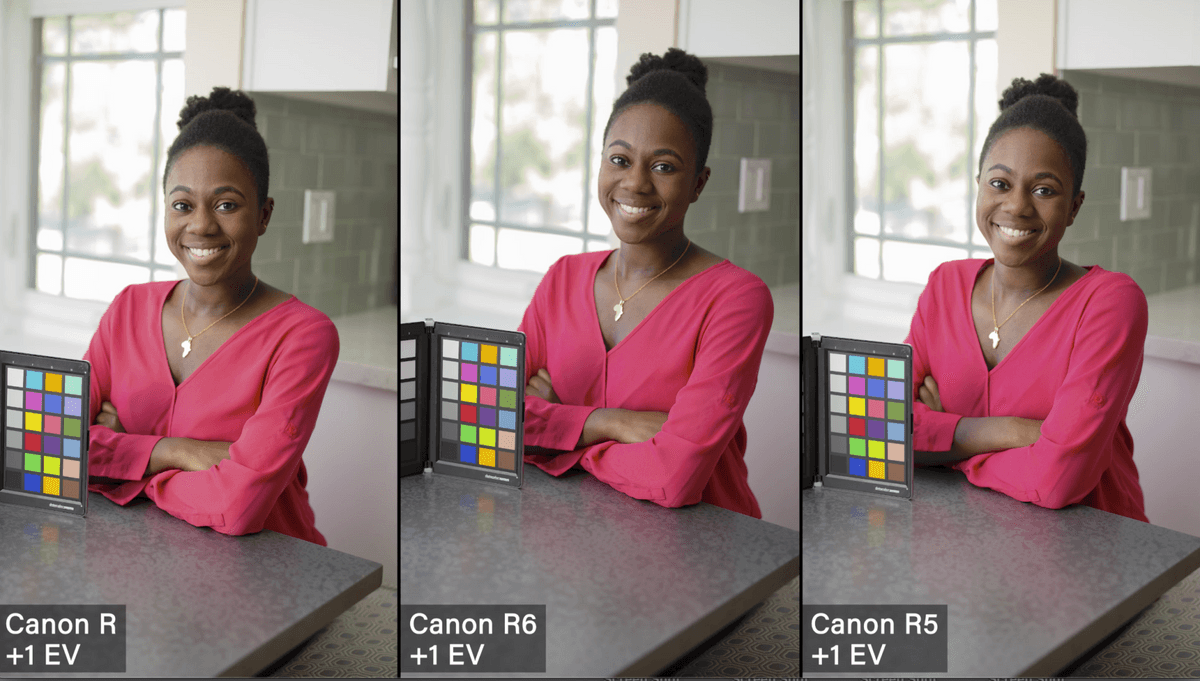
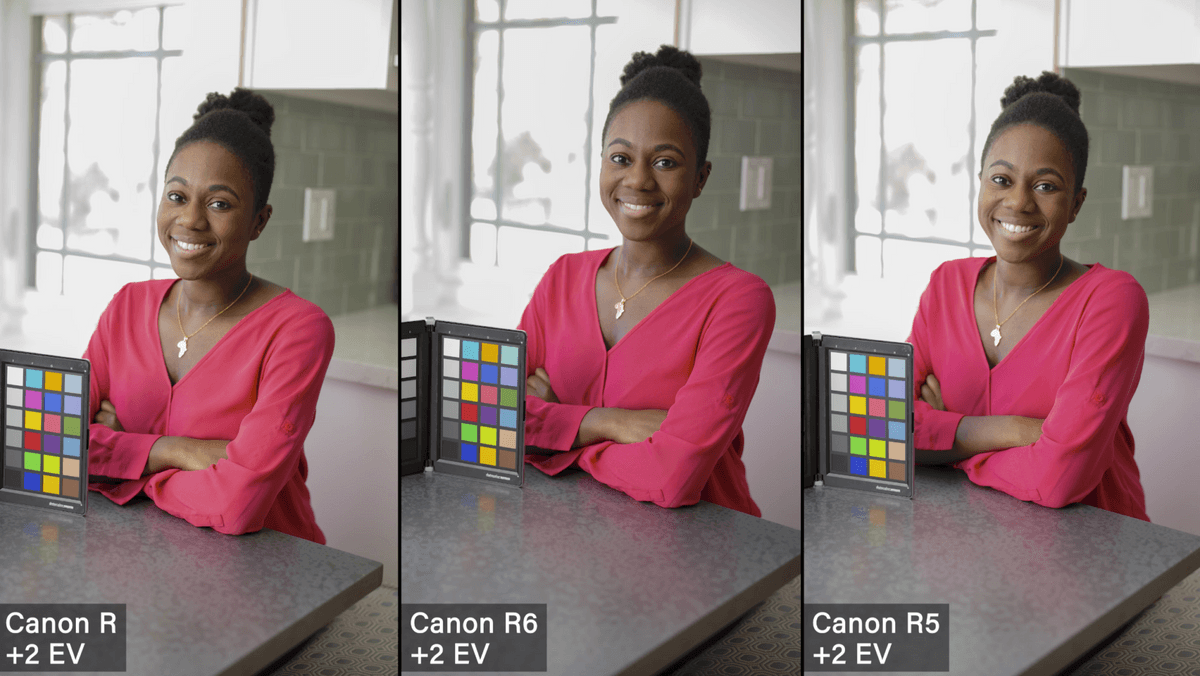
At plus one stop, of course outside the window blows out pretty much immediately. It is very bright out there. But they all look very similar as far as color. It is little green with the R and a little magenta with the R5. The R6 looks pretty good in terms of dynamic range. The highlights look exactly the same.
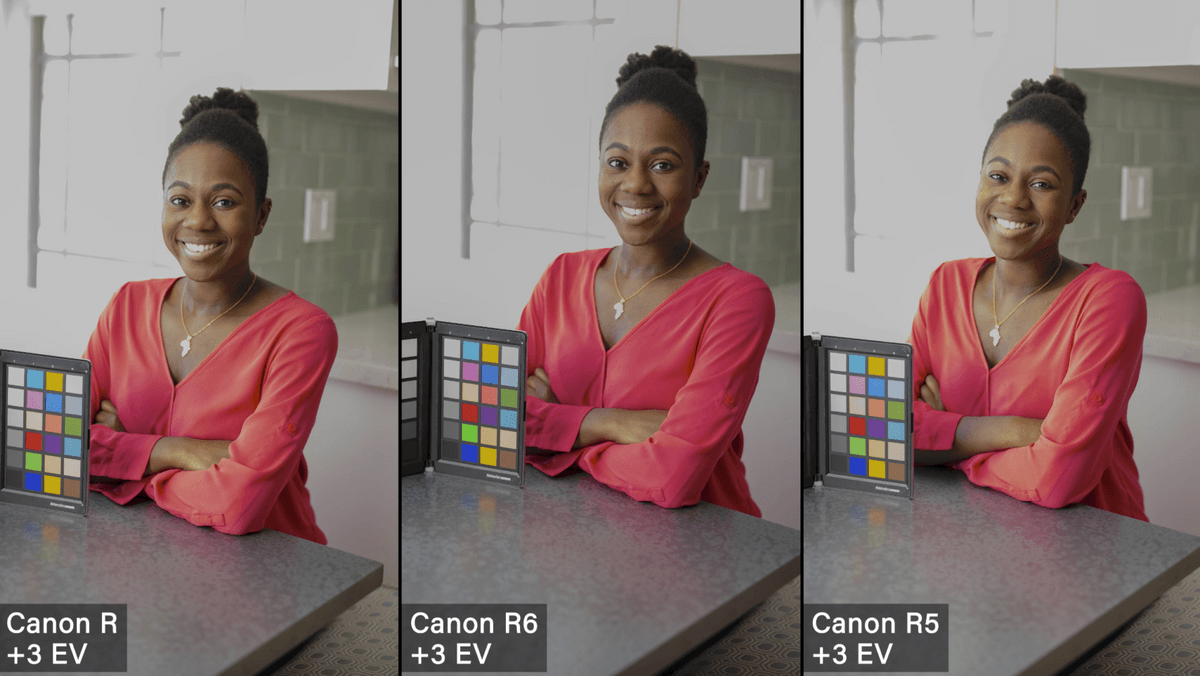
The same for plus three stops here. You do see that the R5 kind of turns yellow. Here her skin’s getting a little messed up. The R6 is still holding on to the color a little bit better. But boy look at those highlights. They look very similar. Although look at the R6. You see the cross braces of the window. You see a little of that with the R but you don’t any of that with the R5. That’s interesting. I think the R6 is a winner. Yeah, it feels like the R6 is very consistent and clean.
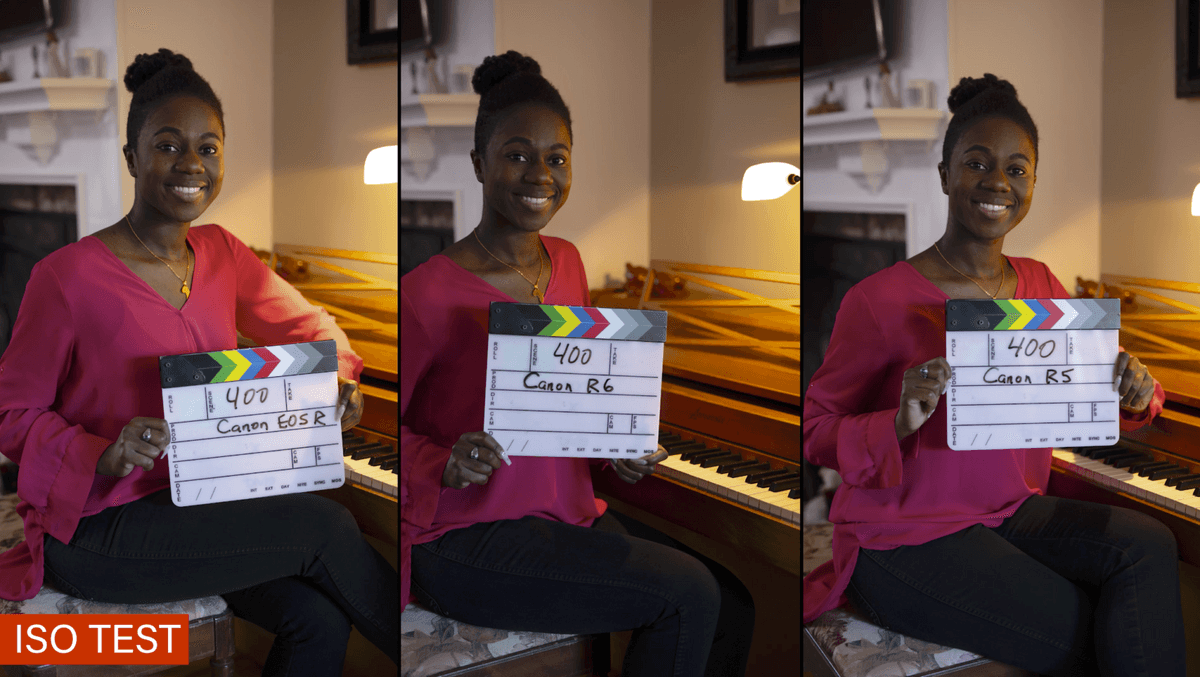
All right, here’s our ISO test. This is a little bit of a mixed lighting test too because we have some warm and cool light coming in here. At 400 ISO all these images are looking very good. Most of these cameras at 400 ISO look great. Let’s see what 800 looks like. 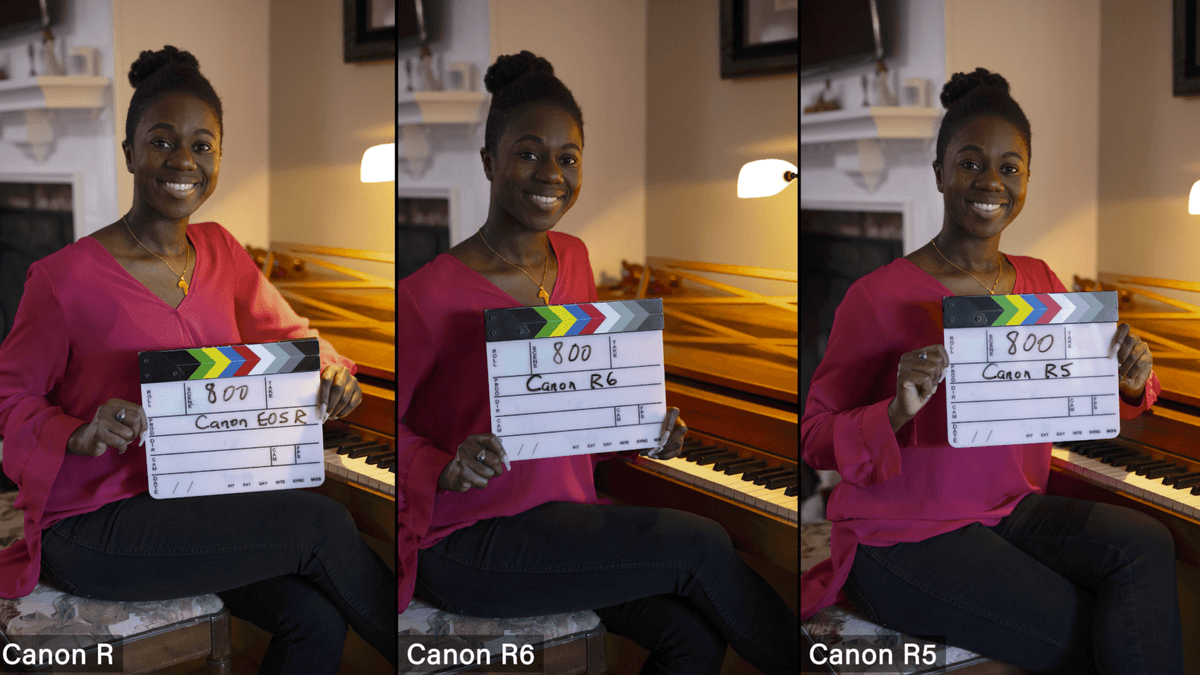 At 800 they’re still so clean. I should point out the R6 is a little darker than the rest and that might have been the case in the dynamic range test. I did try too match the levels on all the exposures and maybe the R6 is a little darker overall. But it’s nothing you can’t correct. 800 ISO looks great.
At 800 they’re still so clean. I should point out the R6 is a little darker than the rest and that might have been the case in the dynamic range test. I did try too match the levels on all the exposures and maybe the R6 is a little darker overall. But it’s nothing you can’t correct. 800 ISO looks great.
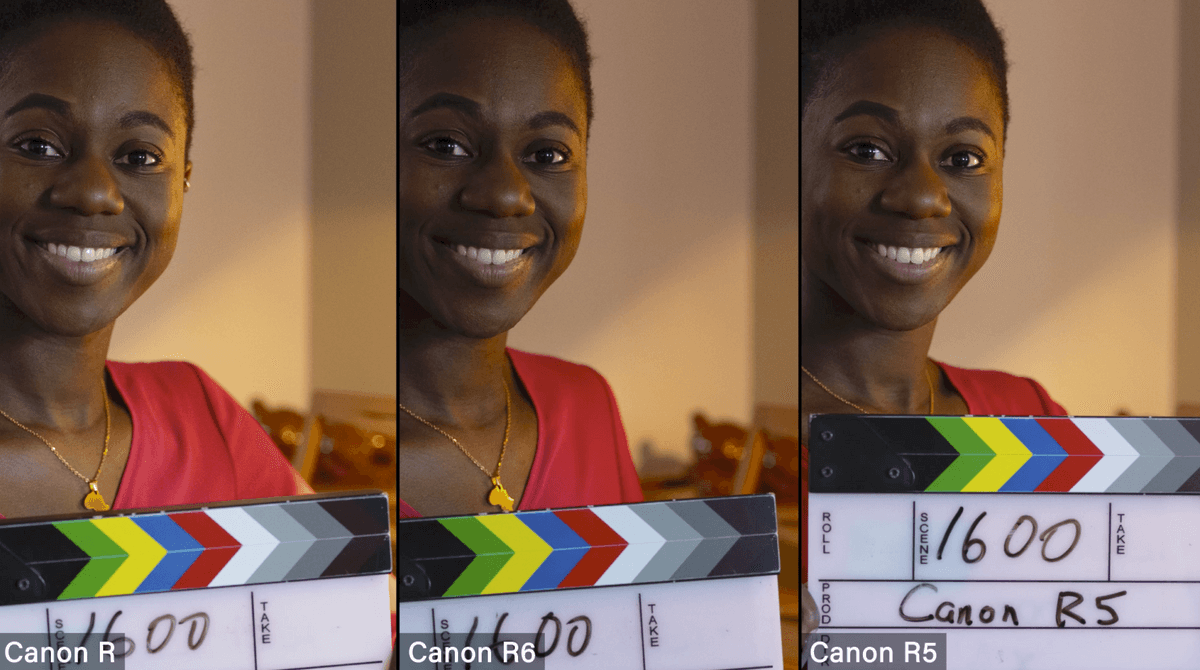
When we go to 1600 I am having a hard time seeing any issues on any of them. Her skin still looks really nice. The grain really is not building at 1600 ISO.
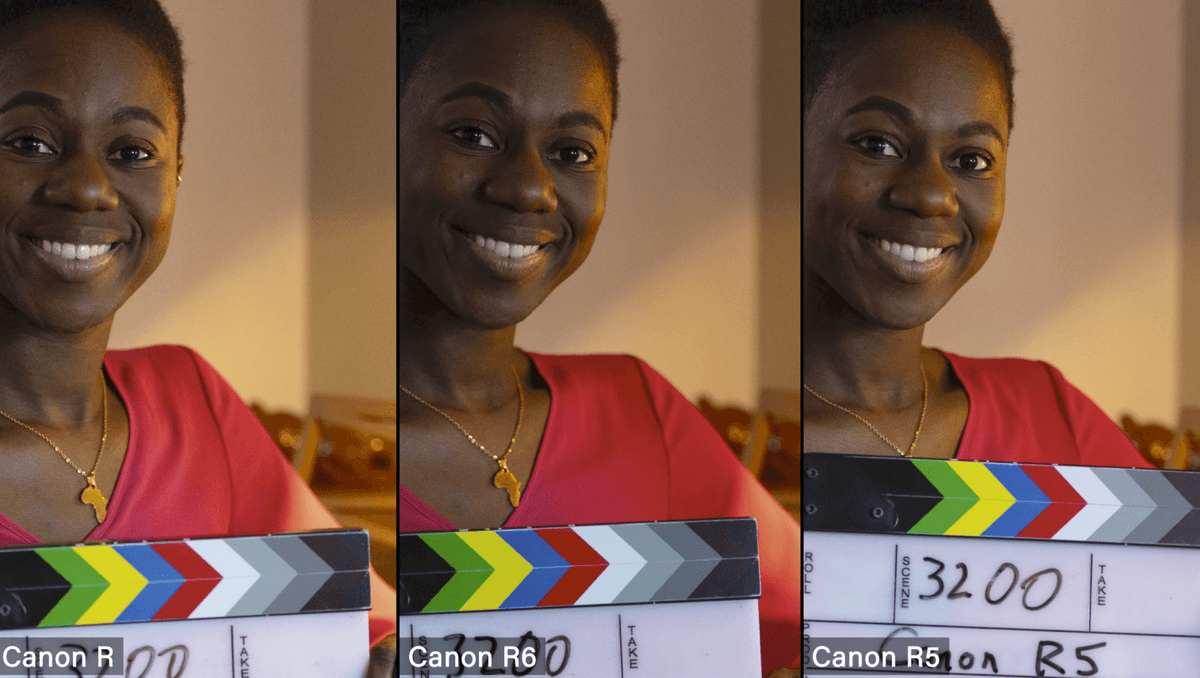
Here at 3200 ISO the R5 is so clean. I’m curious how the R6 would look if we boosted the exposure a little bit but it’s also pretty clean. I like the consistency with the R6 in the the color and everything. With the R you do start seeing grain in her skin and in the wall behind her.
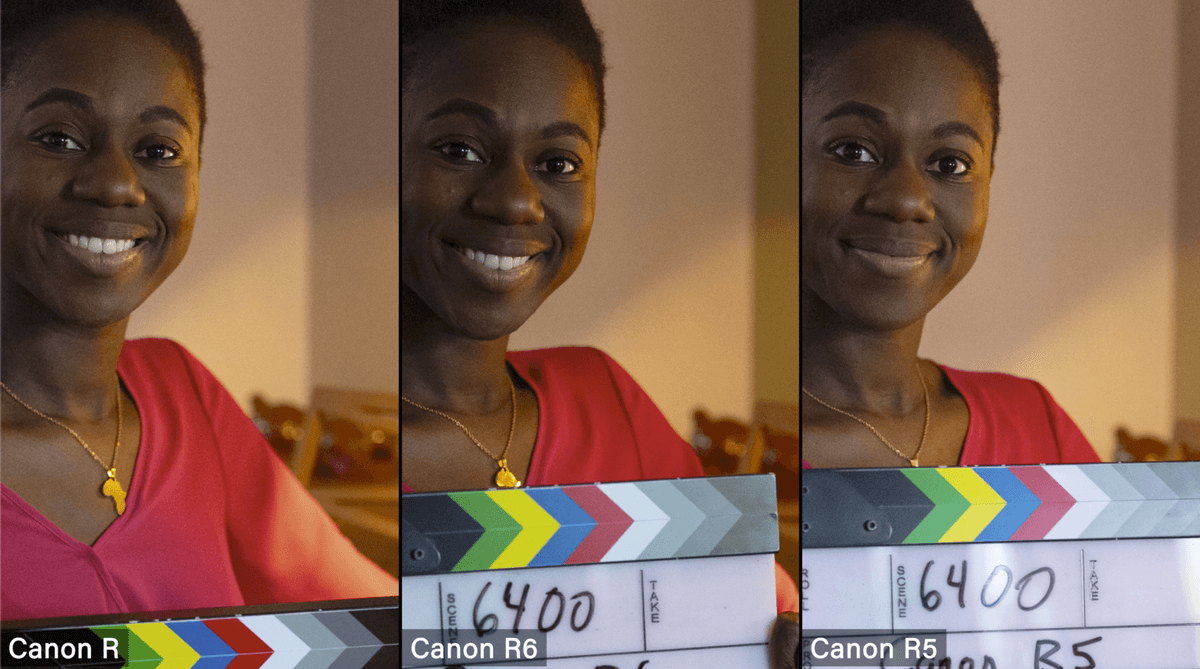
At 6400 ISO is you are starting to see the grain on all the cameras. They are still very similar but the R5 looks much better. And the R6 looks actually worse than the R or similar to the R. I don’t see as much grain in her skin like this cheek on the right.
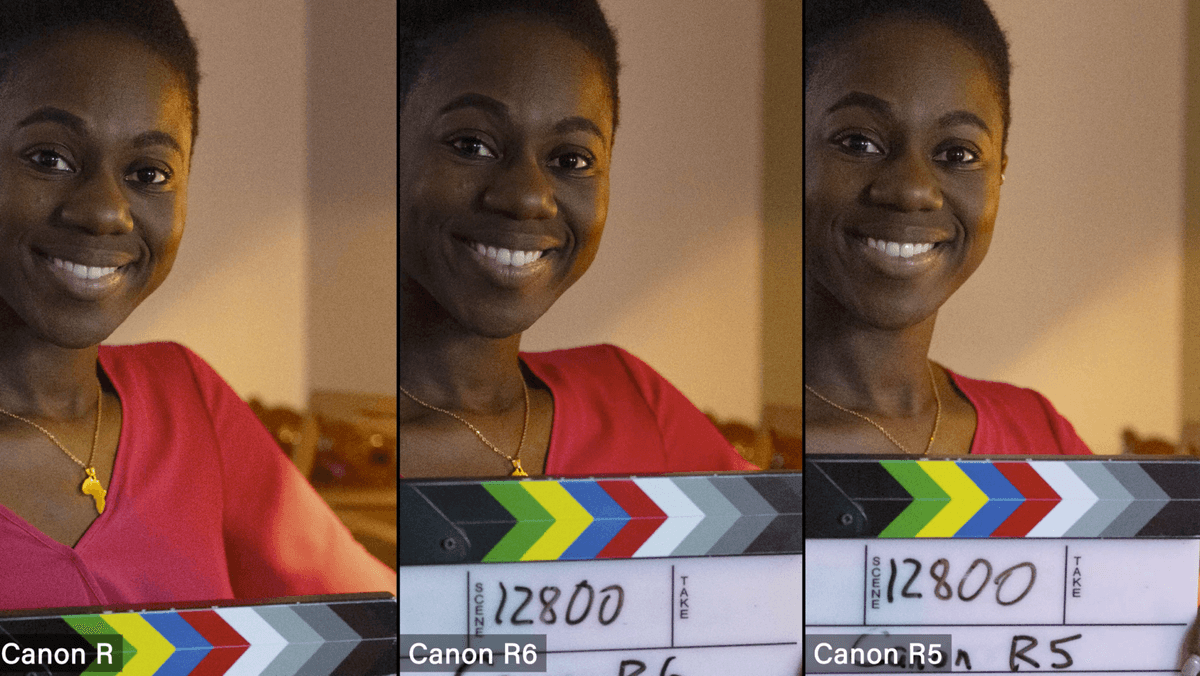
ISO 12,800 isn’t going to look great on any of them. But I think the grain in the R is definitely stronger.
Look at the highlight on her forehead and the green that’s happening on the R is getting a little bit of green on the R6 as well. It’s really interesting. We are seeing some of that in the R5, but it’s holding much better.
It’s interesting the R5 is washing out like it did with the underexposure. It’s losing the contrast. You don’t see great blacks and the whites are not very clear.
The R6 is very consistent with the look, but it is building grain more. And of course the R is not doing as well as the other two. If we’re comparing the R and the R6 particularly, there’s maybe a stop difference at most.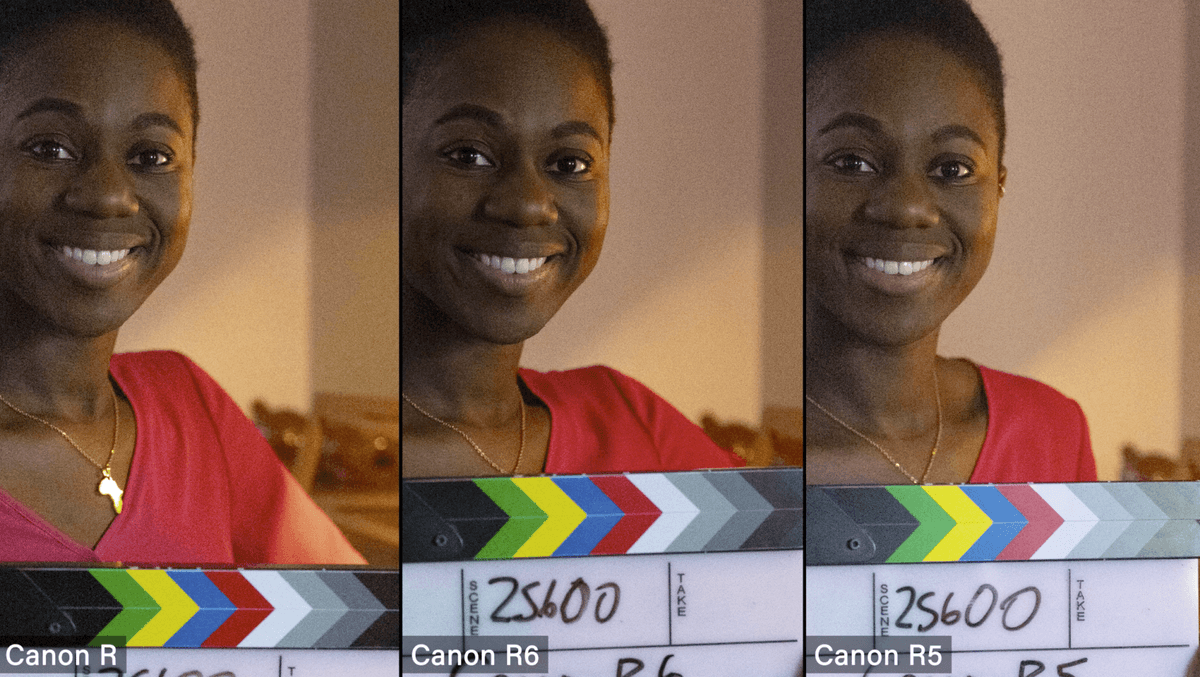
You can go higher with these. I don’t know that it really matters. The R6 goes up to 100,000 ISO. I’m frankly not super impressed by high numbers unless it looks good.
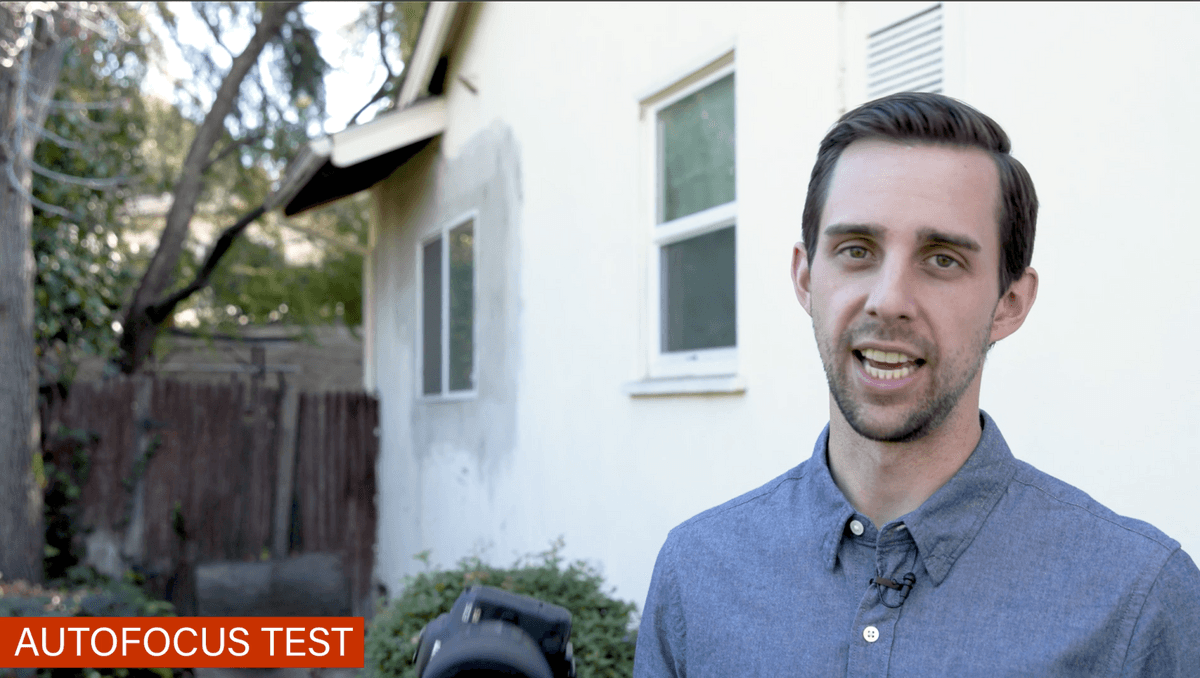
So one of the things about the new Canon cameras is they have the new Canon dual pixel autofocus system, version two. And that’s supposed to be much better than the original, the original is pretty good. I always felt like the Canon R was kind of top of its class in terms of autofocus. 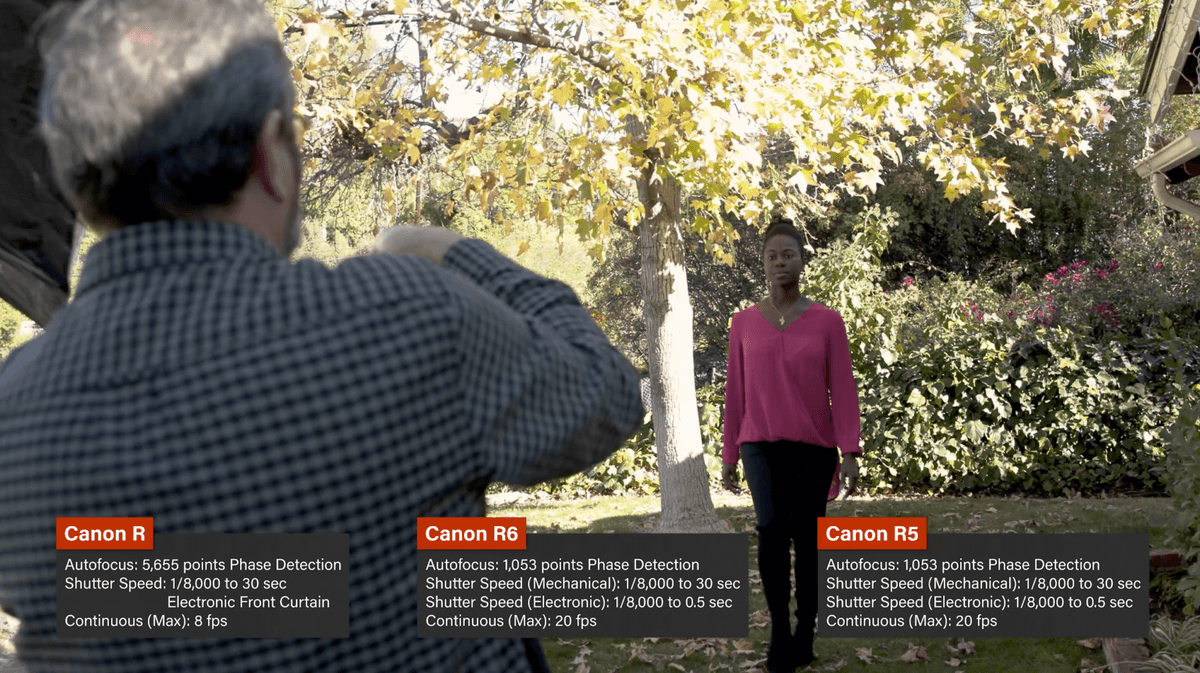 So I’m excited to see how they compare. Let me just say first, we took the best take. We did this multiple times with each camera, we took the best take from all of them.
So I’m excited to see how they compare. Let me just say first, we took the best take. We did this multiple times with each camera, we took the best take from all of them. 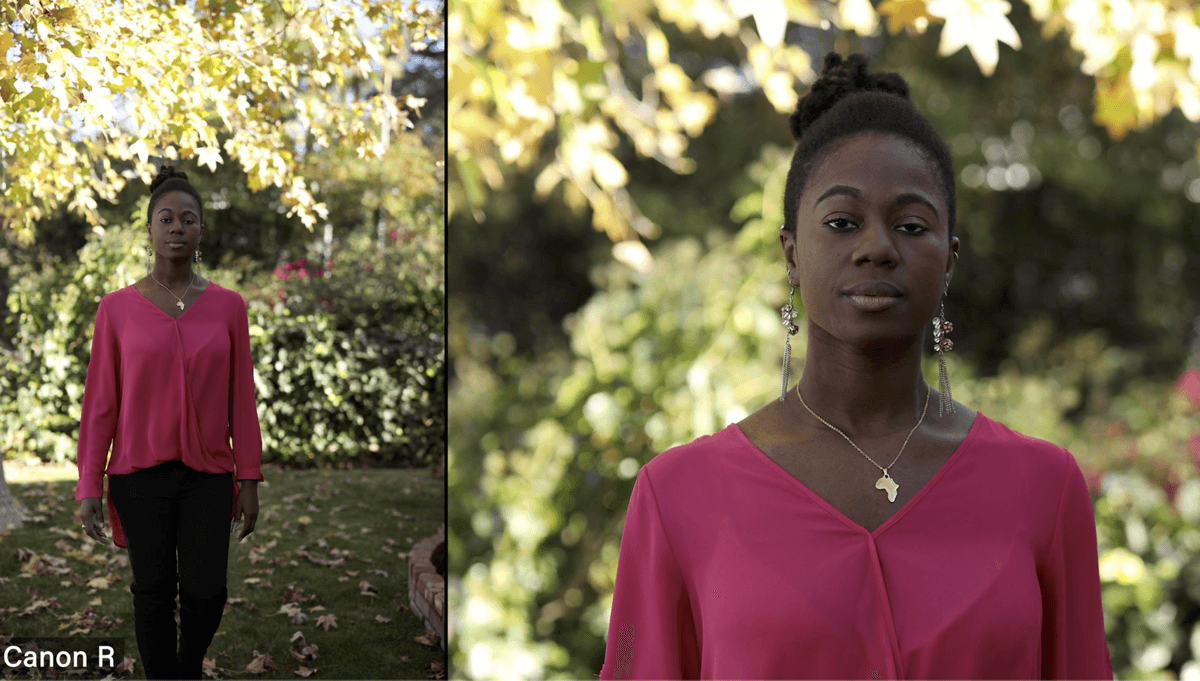 And in that case, almost every single image is focused on her across all three cameras. We have to say that in doing that, it seemed like the R was pretty on with most of the images on each take that we did. We saw more in focus on that one. The R6 was very good.
And in that case, almost every single image is focused on her across all three cameras. We have to say that in doing that, it seemed like the R was pretty on with most of the images on each take that we did. We saw more in focus on that one. The R6 was very good.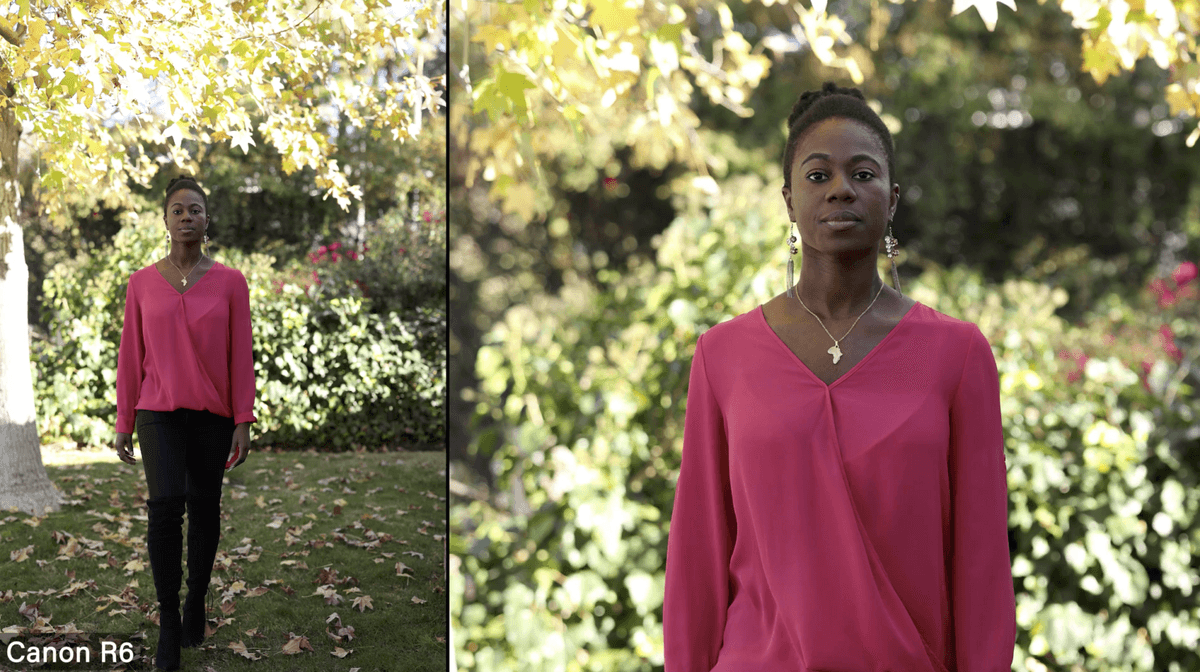 The R6 was by far the best. It was spot on. And that was throughout the day the R6 was very responsive, always sharp, always in focus.
The R6 was by far the best. It was spot on. And that was throughout the day the R6 was very responsive, always sharp, always in focus.
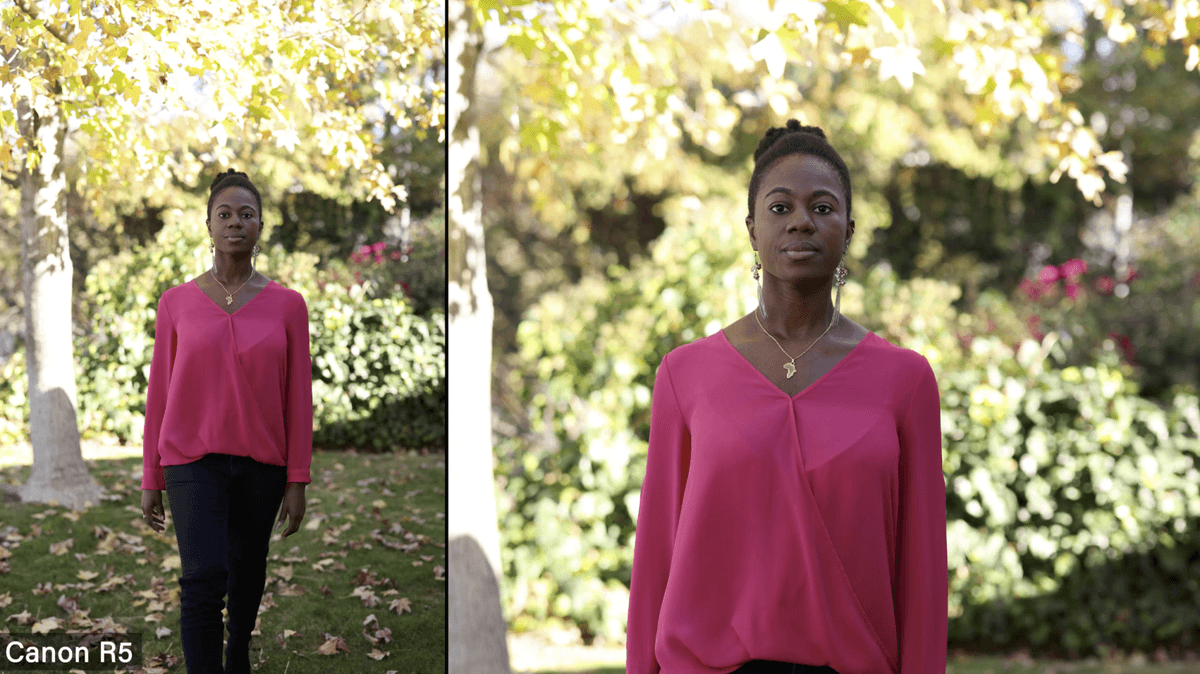
Now the R5 had a lot of images that fell out of focus and it struggled a little bit when it crossed the tree. But we did get a take where it was completely in focus the entire time. So I don’t know how you judge something like that.

I’ll be honest, I think her walking behind the tree really messed it up for the R5. When we did some where she just walked straight towards the camera it was in focus every time. And to that point, we did do a low light autofocus test.
This is really interesting. This is a new test we’ve done in the last couple of camera reviews. And that is we’re at minus four stops. And so you are way underexposed, which means that the cameras are not getting enough light. And you’re having to keep focus as the person walks towards the camera in that really low light situation.
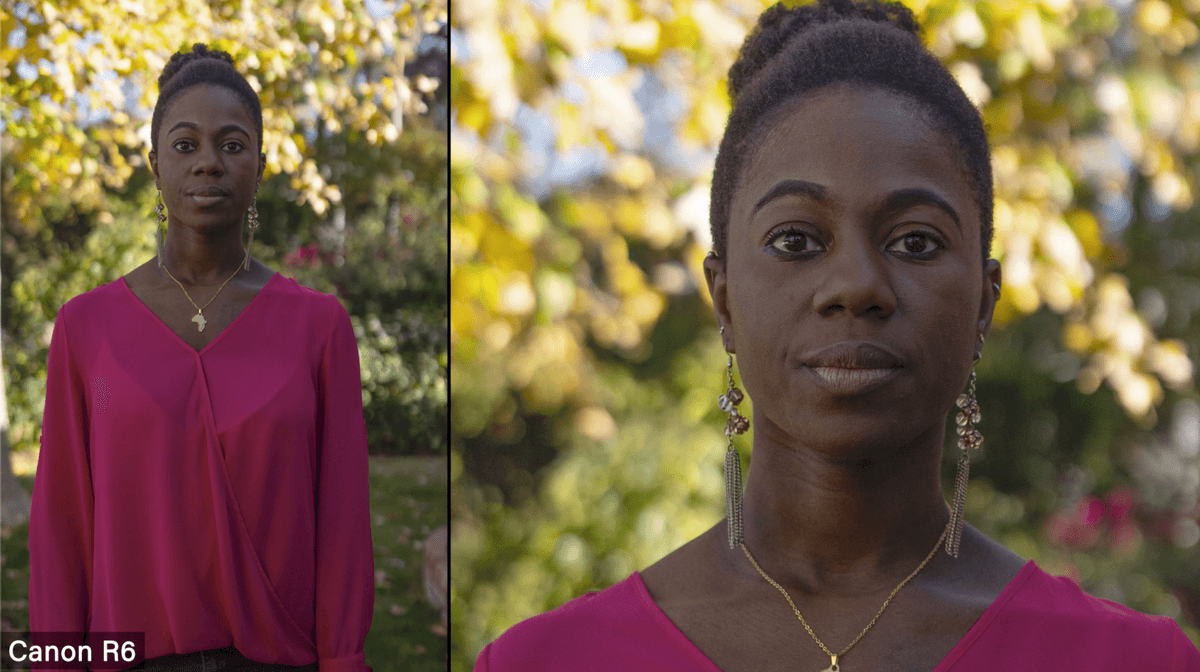
The R6 did phenomenal. There are some images that are a little soft and not quite on her eye. But it is tracking her in most of the images. Most of the images are sharp and acceptable to my judgment. 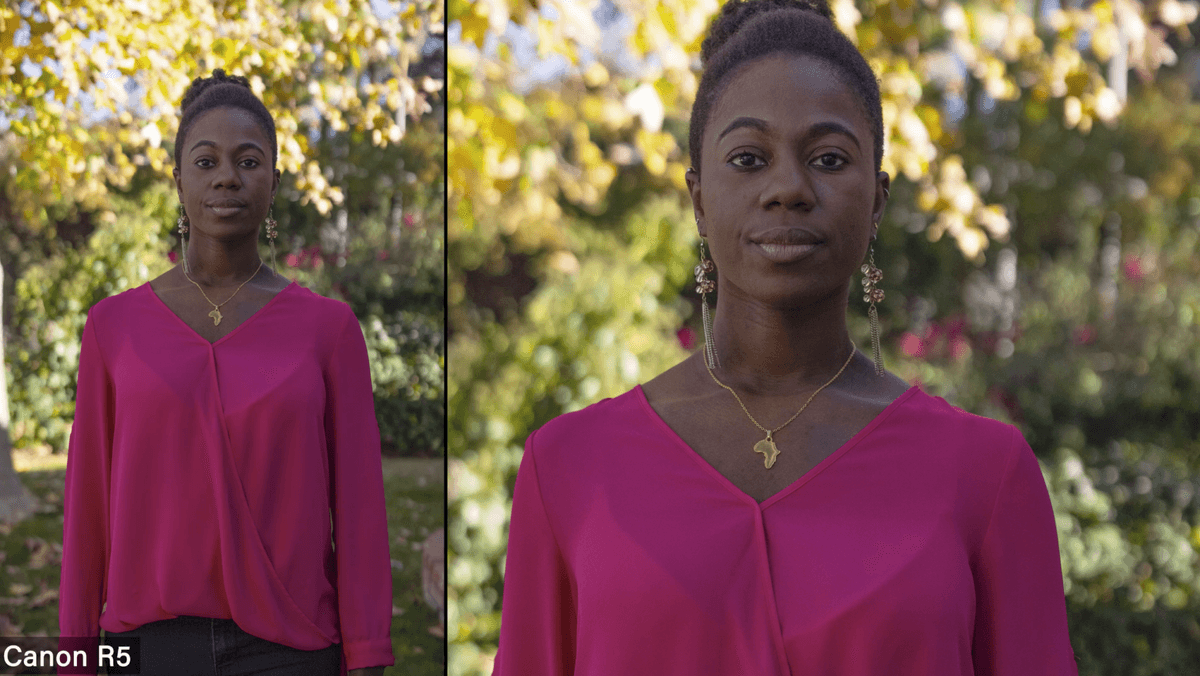 The R5 also did really well in the scenario. It didn’t skip a beat. And in fact, I would say it performed on par with the R6 again. Maybe a little bit of softness here and there, but overall very acceptable tracking.
The R5 also did really well in the scenario. It didn’t skip a beat. And in fact, I would say it performed on par with the R6 again. Maybe a little bit of softness here and there, but overall very acceptable tracking. 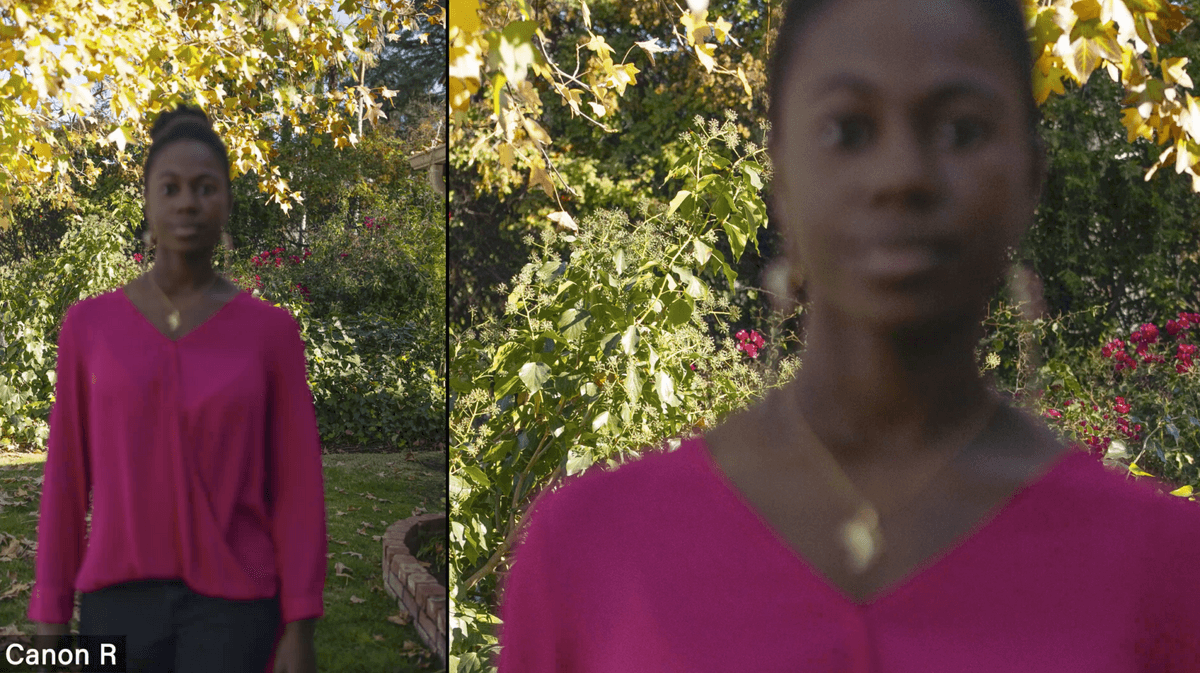 The R really struggled. It held on to her until she walked into the shadow and then it was gone. It lost her and never found her again. We did it a few times with the R and it did not find her again. It could not figure it out. I think of all of the tests we’ve done, the autofocus is the one where the R5 and the R6 far outstripped the R. They definitely did. The R held up very well in the open light test. It seemed to be just fine. But when you’re pressure testing, the R5 and R6 blew me away. They were so good.
The R really struggled. It held on to her until she walked into the shadow and then it was gone. It lost her and never found her again. We did it a few times with the R and it did not find her again. It could not figure it out. I think of all of the tests we’ve done, the autofocus is the one where the R5 and the R6 far outstripped the R. They definitely did. The R held up very well in the open light test. It seemed to be just fine. But when you’re pressure testing, the R5 and R6 blew me away. They were so good.

So let’s take a look at video with these three cameras, because this is the area that I really feel like the R is a better choice over the other two. Just because the R delivers and doesn’t shut down and overheat. But it has some significant disadvantages.
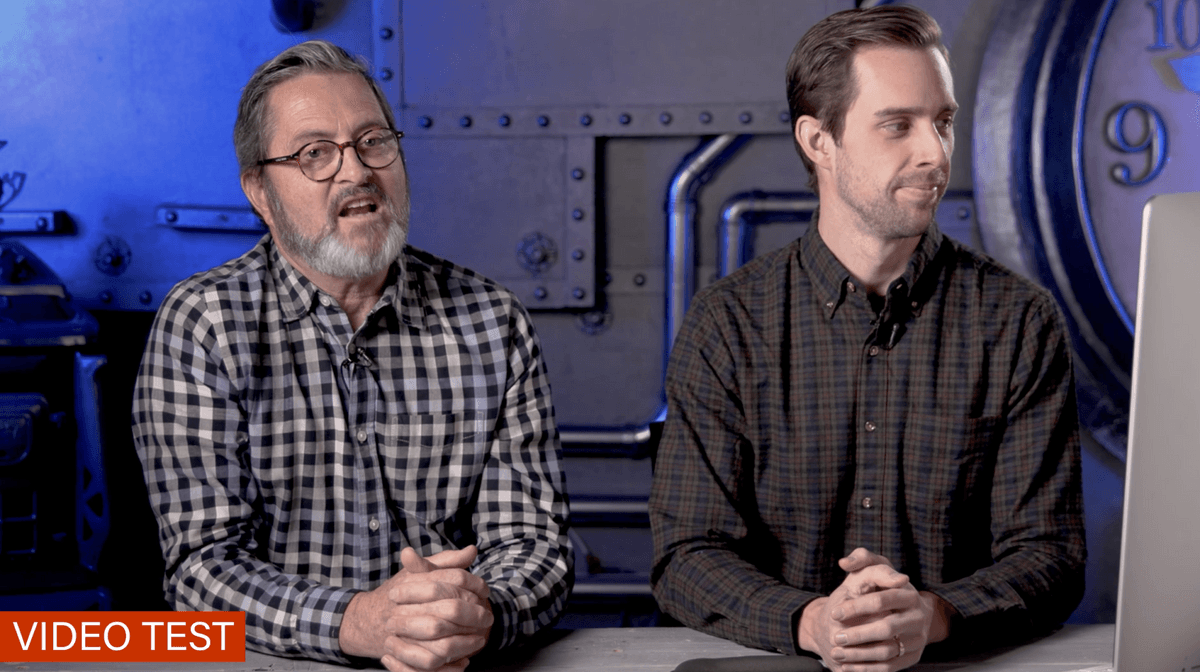
Let me talk about the disadvantages here for a second. First of all, as you can see, already, I took all of these video clips just standing, leaning against the doorway and really trying to stabilize the video. I’m not trying to move the camera at all. Same lens, same position, you obviously see the crop factor, which is the number one disadvantage of the R. You cannot get a wide shot to save your life. But that camera because the crop is so intense, this is a 50 millimeter lens, you compare the composition on the R to the composition of the other two cameras. Second of all, the image stabilization, the R doesn’t have it and you’ll see that the R is very shaky. You have to keep that thing on a tripod. You cannot handle that thing very easily. The IBIS on the R5 and R6 are both really good. And it is really beautiful.
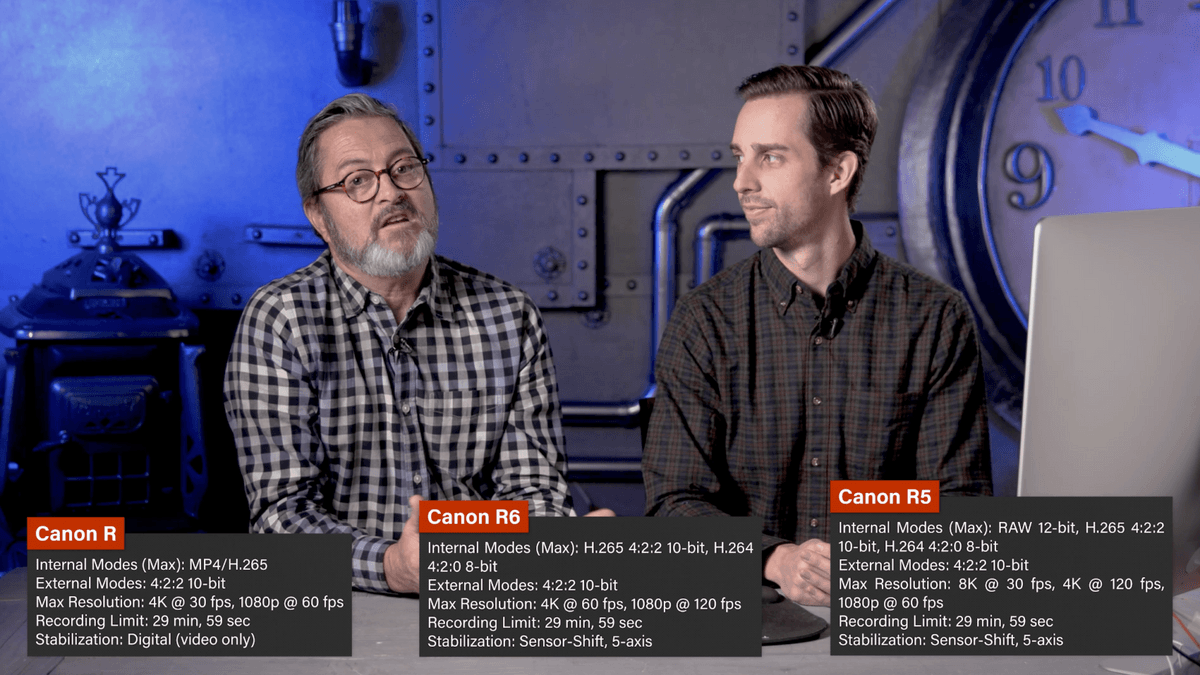
Finally, looking at it without zooming in, I can see the noise on the R versus the R5 and the R6. There were shot at 800 ISO and you do see it just with your eyeballs in a small frame with the R. The R5 and R6 are very clean. So the R5 and R6 have superior video capabilities. If they could just bring them to the party all the time and not overheat. And that is the problem. I did an overheating test. I got about two clips, about an hour and about 10 minutes with the R6 before it completely shut down.
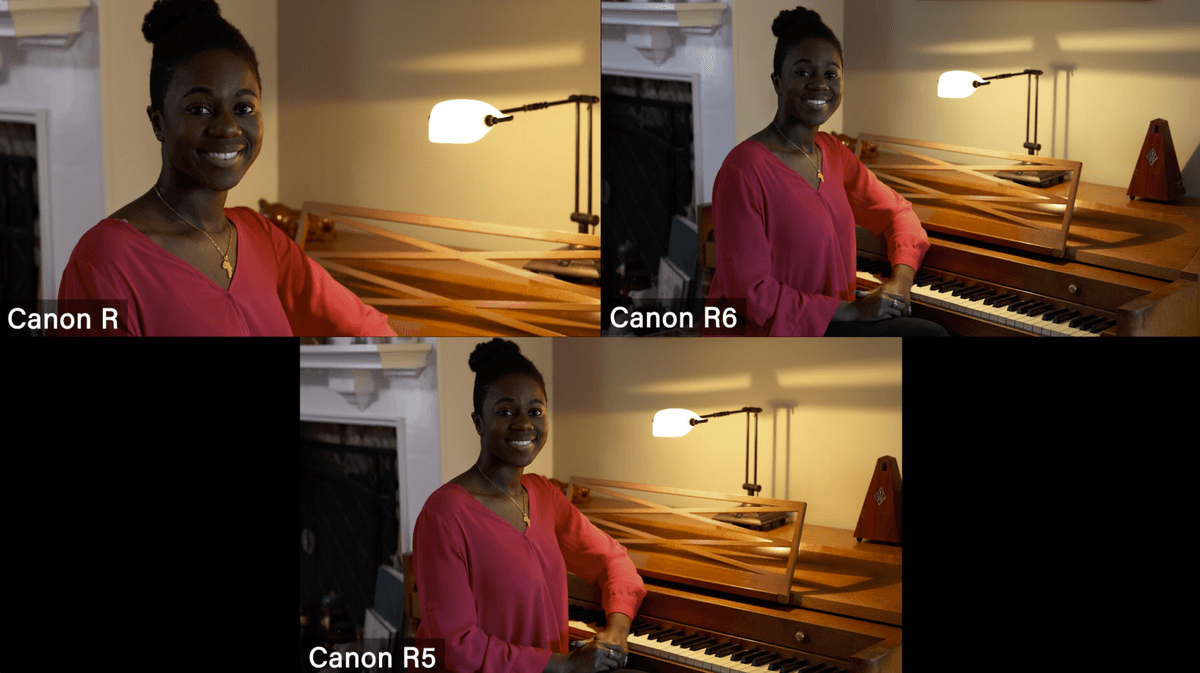
I think if someone handed me two cameras and said, “Well, this one takes better video, but it might overheat after 25 minutes”, I would have a hard time picking that one because you just never know what the scenario will be. And then all of a sudden you don’t have a camera. It’s like standing there and not having a camera. “Oh, I’m sorry, I can’t shoot this right now.” It just doesn’t work. So if you had to buy one of these cameras as a crossover camera, you could not make the argument that the R5 is a worse still camera than the R. The R five is by far the most superior still camera, I think on the market. But if you want the best crossover camera in the R series, what’s the best crossover camera? I think it’s the R. Just because you can use it consistently and it’s not going to overheat on you. And you also get a great image as we’ve seen. Invest in the glass, that’s really important to future proofing yourself. If you get great glass, you’ll be able to use that for years. The glass will probably make a bigger difference on your image than any of the actual cameras. In this case, if you’re just shooting video, or if you’re just shooting stills, all of the images from the cameras were similar. But the lenses are going to make a huge difference.

So there you have it. You’ll have to make your own decision. It depends on your situation, how you’re going to use a camera and what’s important to you. But as I’m looking at these things, the images are not that different. But you do have a video capability with the R that you don’t get with the R6 and the R5 because they overheat. 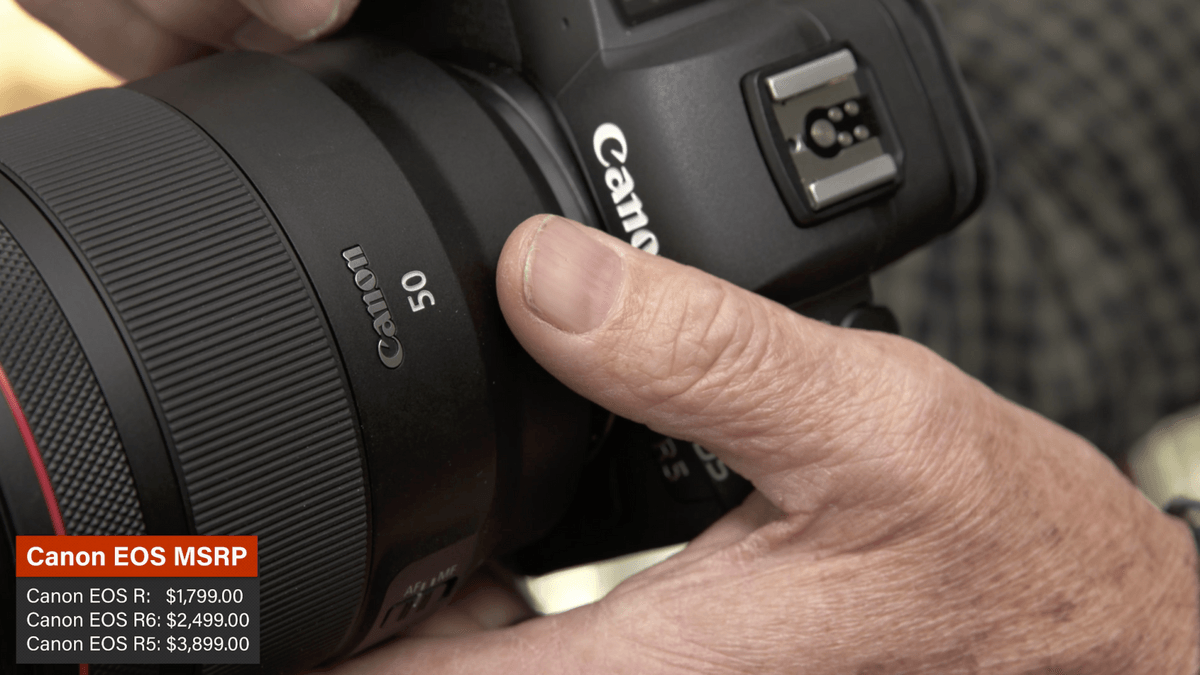 So I’m sticking with the R at this point. I own the R. I bought the R5 and then I sent it back. I was ready to pay the money and step up. I’d have the R5 right now if it didn’t overheat and be so super happy about it. So it’s so unfortunate.
So I’m sticking with the R at this point. I own the R. I bought the R5 and then I sent it back. I was ready to pay the money and step up. I’d have the R5 right now if it didn’t overheat and be so super happy about it. So it’s so unfortunate.  Alright, so make sure you Subscribe here to The Slanted Lens and ring that bell so you get notified every time we have a video up. And keep those cameras rollin’ and keep on clickin’.
Alright, so make sure you Subscribe here to The Slanted Lens and ring that bell so you get notified every time we have a video up. And keep those cameras rollin’ and keep on clickin’.
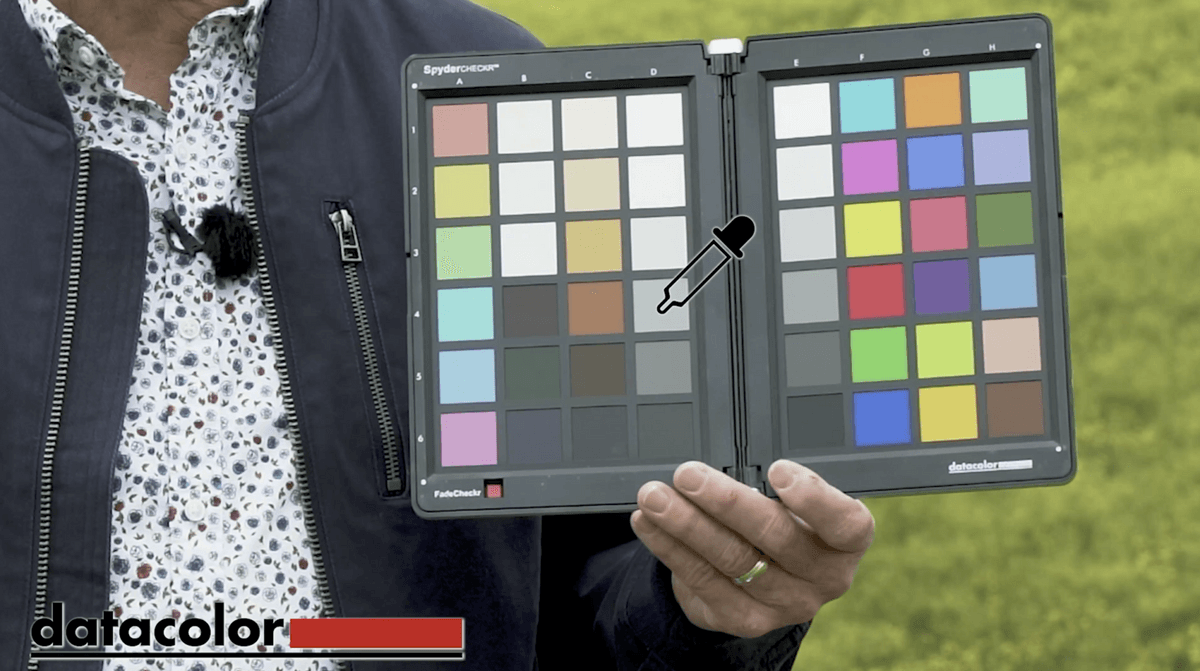
Get your SpyderCheckr from Datacolor. Click on the 80% gray when you are editing and you can color balance your footage. you get a great starting point. It’s just that easy.